#so that when I apply for the Animation and Game Design track it looks good
Text
「viRtua canm0m」 Project :: 002 - driving a vtuber
That about wraps up my series on the technical details on uploading my brain. Get a good clean scan and you won't need to do much work. As for the rest, well, you know, everyone's been talking about uploads since the MMAcevedo experiment, but honestly so much is still a black box right now it's hard to say anything definitive. Nobody wants to hear more upload qualia discourse, do they?
On the other hand, vtubing is a lot easier to get to grips with! And more importantly, actually real. So let's talk details!
Vtubing is, at the most abstract level, a kind of puppetry using video tracking software and livestreaming. Alternatively, you could compare it to realtime mocap animation. Someone at Polygon did a surprisingly decent overview of the scene if you're unfamiliar.
Generally speaking: you need a model, and you need tracking of some sort, and a program that takes the tracking data and applies it to a skeleton to render a skinned mesh in real time.
Remarkably, there are a lot of quite high-quality vtubing tools available as open source. And I'm lucky enough to know a vtuber who is very generous in pointing me in the right direction (shoutout to Yuri Heart, she's about to embark on something very special for her end of year streams so I highly encourage you to tune in tonight!).
For anime-style vtubing, there are two main types, termed '2D' and 3D'. 2D vtubing involves taking a static illustration and cutting it up to pieces which can be animated through warping and replacement - the results can look pretty '3D', but they're not using 3D graphics techniques, it's closer to the kind of cutout animation used in gacha games. The main tool used is Live2D, which is proprietary with a limited free version. Other alternatives with free/paid models include PrPrLive and VTube studio. FaceRig (no longer available) and Animaze (proprietary) also support Live2D models. I have a very cute 2D vtuber avatar created by @xrafstar for use in PrPrLive, and I definitely want to include some aspects of her design in the new 3D character I'm working on.

For 3D anime-style vtubing, the most commonly used software is probably VSeeFace, which is built on Unity and renders the VRM format. VRM is an open standard that extends the GLTF file format for 3D models, adding support for a cel shading material and defining a specific skeleton format.
It's incredibly easy to get a pretty decent looking VRM model using the software VRoid Studio, essentially a videogame character creator whose anime-styled models can be customised using lots of sliders, hair pieces, etc., which appears to be owned by Pixiv. The program includes basic texture-painting tools, and the facility to load in new models, but ultimately the way to go for a more custom model is to use the VRM import/export plugin in Blender.
But first, let's have a look at the software which will display our model.
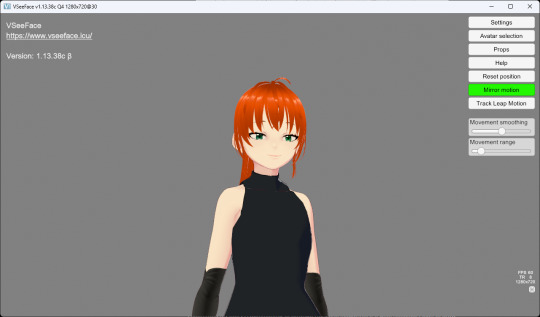
meet viRtua canm0m v0.0.5, a very basic design. her clothes don't match very well at all.
VSeeFace offers a decent set of parameters and honestly got quite nice tracking out of the box. You can also receive face tracking data from the ARKit protocol from a connected iPhone, get hand tracking data from a Leap Motion, or disable its internal tracking and pipe in another application using the VMC protocol.
If you want more control, another Unity-based program called VNyan offers more fine-grained adjustment, as well as a kind of node-graph based programming system for doing things like spawning physics objects or modifying the model when triggered by Twitch etc. They've also implemented experimental hand tracking for webcams, although it doesn't work very well so far. This pointing shot took forever to get:
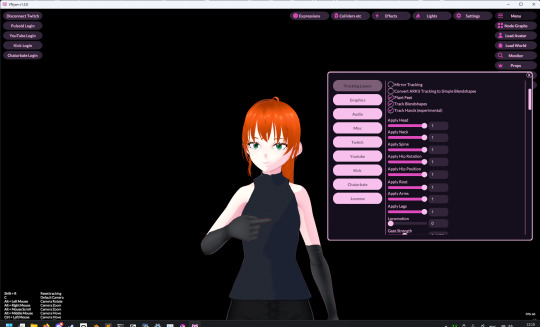
<kayfabe>Obviously I'll be hooking it up to use the output of the simulated brain upload rather than a webcam.</kayfabe>
To get good hand tracking you basically need some kit - most likely a Leap Motion (1 or 2), which costs about £120 new. It's essentially a small pair of IR cameras designed to measure depth, which can be placed on a necklace, on your desk or on your monitor. I assume from there they use some kind of neural network to estimate your hand positions. I got to have a go on one of these recently and the tracking was generally very clean - better than what the Quest 2/3 can do. So I'm planning to get one of those, more on that when I have one.
Essentially, the tracker feeds a bunch of floating point numbers in to the display software at every tick, and the display software is responsible for blending all these different influences and applying it to the skinned mesh. For example, a parameter might be something like eyeLookInLeft. VNyan uses the Apple ARKit parameters internally, and you can see the full list of ARKit blendshapes here.
To apply tracking data, the software needs a model whose rig it can understand. This is defined in the VRM spec, which tells you exactly which bones must be present in the rig and how they should be oriented in a T-pose. The skeleton is generally speaking pretty simple: you have shoulder bones but no roll bones in the arm; individual finger joint bones; 2-3 chest bones; no separate toes; 5 head bones (including neck). Except for the hands, it's on the low end of game rig complexity.
Expressions are handled using GLTF morph targets, also known as blend shapes or (in Blender) shape keys. Each one essentially a set of displacement values for the mesh vertices. The spec defines five default expressions (happy, angry, sad, relaxed, surprised), five vowel mouth shapes for lip sync, blinks, and shapes for pointing the eyes in different directions (if you wanna do it this way rather than with bones). You can also define custom expressions.
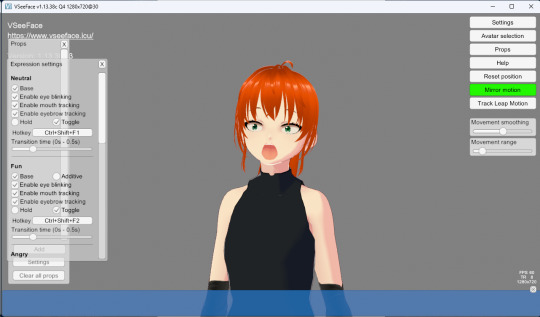
This viRtua canm0m's teeth are clipping through her jaw...
By default, the face-tracking generally tries to estimate whether you qualify as meeting one of these expressions. For example, if I open my mouth wide it triggers the 'surprised' expression where the character opens her mouth super wide and her pupils get tiny.
You can calibrate the expressions that trigger this effect in VSeeFace by pulling funny faces at the computer to demonstrate each expression (it's kinda black-box); in VNyan, you can set it to trigger the expressions based on certain combinations of ARKit inputs.
For more complex expressions in VNyan, you need to sculpt blendshapes for the various ARKit blendshapes. These are not generated by default in VRoid Studio so that will be a bit of work.
You can apply various kinds of post-processing to the tracking data, e.g. adjusting blending weights based on input values or applying moving-average smoothing (though this noticeably increases the lag between your movements and the model), restricting the model's range of movement in various ways, applying IK to plant the feet, and similar.
On top of the skeleton bones, you can add any number of 'spring bones' which are given a physics simulation. These are used to, for example, have hair swing naturally when you move, or, yes, make your boobs jiggle. Spring bones give you a natural overshoot and settle, and they're going to be quite important to creating a model that feels alive, I think.
Next up we are gonna crack open the VRoid Studio model in Blender and look into its topology, weight painting, and shaders. GLTF defines standard PBR metallicity-roughness-normals shaders in its spec, but leaves the actual shader up to the application. VRM adds a custom toon shader, which blends between two colour maps based on the Lambertian shading, and this is going to be quite interesting to take apart.
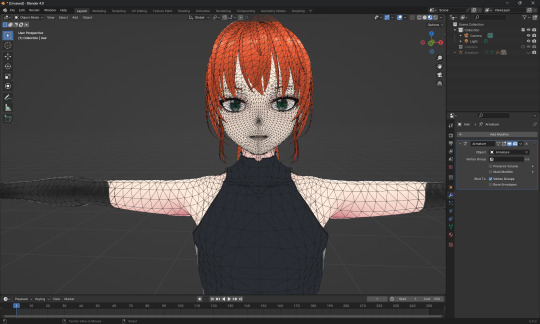
The MToon shader is pretty solid, but ultimately I think I want to create custom shaders for my character. Shaders are something I specialise in at work, and I think it would be a great way to give her more of a unique identity. This will mean going beyond the VRM format, and I'll be looking into using the VNyan SDK to build on top of that.
More soon, watch this space!
9 notes
·
View notes
Text
he gets called it every day by a multitude of people in the fanbase, but i don’t agree that jin’s an “edgelord.” with the exception of certain portrayals (namely TK6 and crossover games) - i sincerely believe jin doesn’t fit the bill for an “edgelord.” what makes an edgelord exactly? the term edgelord is typically applied to characters (or people) that are extremely nihilistic and hate other people, or those who are overly offensive or violent for nothing more than to appear “badass/cool” or “shocking” - usually to the point where it’s embarrassing. an d i don’t think jin belongs in either of those descriptions.
yes, jin is depressed, and straight out suicidal. this can be seen as nihilistic... except - jin isn’t nihilistic. he doesn’t view people as bad, nor does he view the earth as, too. the only people he hates / views as bad is himself, and his family. and for good reason, his family has a track record of being abusive, power hungry / greedy, traitorous, and unloving. jin just isn’t hating them because he thinks they’re bad, he knows they’re bad - they’ve proven it. meanwhile, when it comes to other people, jin typically avoids them because of his antisocial behavior, but he is never intentionally rude to them, nor does he go out of is way to be cruel to anyone. in fact, sometimes he can even be supportive of people. such as having told people (like xiao) to follow their dreams, not minding if hwoarang sees himself as “stronger” than him, and apologizing for when he feels he should. and jin mostly avoids social interactions in order to avoid harming people - he wants the world to be a better place, it’s why he wants to get rid of himself and his family - because he views this as the only way to improve the world, and help people.
and jin’s suicidal tendencies aren’t only because “i’m emo and i wanna die!” he genuinely believes that it is the only way to stop his devil from destroying the world. if a person has a parasitic monster that takes over their body and kills people - you may look at it and think “well... this thing needs its host to survive. if i, the host, were to die - then more people won’t.” it can be argued that this is a heroic sacrifice (as this happens often in movies - one of the heroes sacrifices themselves in order to save everyone else.)
finally, jin isn’t particularly violent, either. yes, he’s a fighter - but despite the fact that his devil takes over when he loses his temper, we don’t really see jin losing his temper to the point where he’s beating someone half to death. the most we saw this happen was in the anime. while jin doesn’t turn down a fight, he doesn’t seem to love one, either. after all, during hwoarang’s ending in TK4, jin specifically tells hwoarang that there’s no need to fight, oftentimes - hwoarang wants to fight and jin rejects it. i feel this is supposed to show that jin doesn’t like to fight unless it’s necessary. much like how the comic, and anime pointed out - this is what makes jin different from his father, and grandfather - he doesn’t find pleasure in harming other people. and also, as a quick side note - jin doesn’t have an excessive potty mouth - worse we may hear him say are minor swears (like damn or bastard) sometimes.
so yeah, other than his design being “dark/cool” i don’t think jin is an edgelord. i think people are mistaking “understandably miserable character” for “edgy.”
5 notes
·
View notes
Text
I feel like I have so much time in the day now that Whumptober is done, so I decided to pre-make my schedule for next year, and Jesus Christ I might just cry if I have to actually commute into the city next semester:

And this is with my Introduction Film Class having TBA status so that I can start my Film and Media Studies minor. I feel like hitting my head against the wall.
I live in NY/LI for reference, so this is a train into Penn and the city (~40 mins).
#I don't technically have to start my film minor now but I want to get ahead of everyone else (since I already had 62 credits coming in)#so that when I apply for the Animation and Game Design track it looks good#also the film classes look fun#H O W E V E R#I have no idea if I am going to be able to handle being alone on a train at 5/6 every night because I get easily paranoid and afraid that#someone is going to skin me alive or kidnap me or sa me#online learning has made me so spoiled because like if it's online next semester?#this schedule will not be a problem in the slightest#in fact I literally chose my intro to film class as an online one because I prefer that method of learning half the time#I'm literally doing fine in sculpture through online learning#it's the commutes that kills me#all day spent working and on trains was what made me develop skin picking/hair pulling nervous ticks at my old college that I still have#I wish the school had more online options because I would take all these classes that way#and like I shouldn't hope that everything will be online because that obviously means the virus is still around and that's horrible#it's just a method of learning that works well for me and I wish more colleges had those options without a pand/emic happening#writing.txt
2 notes
·
View notes
Text
I LOVE No Straight Roads
Honestly it’s hard to keep me away from a game with great visuals and even greater character design. I knew from the INSTANT I saw these characters that I was going to love it. I just finished it because it’s (unfortunately) pretty short, and even though I cheesed the final boss through it’s very lenient death mechanics (Instant respawn at the cost of a good rank) I actually appreciated that it wasn’t a pure cake walk. I’ve yet to rematch all of the bosses, but since I had genuine trouble with the later ones I’ll hold off on that.
But who cares about gameplay, am I right? I sure as hell don’t. I would’ve bought the game no matter what the hell it was. I wanted the characters (and the music, although I realized that second) and that was it.
First of all, I love any world that is super fantastical but cheesy in its concept, ala a city powered by music, and battles between artists using music. Ideas like this only spawn from a mind that wants to create a fun atmosphere, if nothing else, and it was sure as hell fun. I genuinely love when someone goes so far into a crazy idea and doesn’t waste your time explaining it with real world logic. Wanna know how a city can be powered by music? Shut up and look at the cute virtual mermaid. Lord knows I did. Every once in a while, it does you good to just let the player/reader/viewer just revel in the idea without having to go out of your way to make things seem realistic. It’s not about “turning your brain off” or whatever, it’s picking your battles.
Also, I can seriously love a world with great background characters to it. Any game with the right situation to insert the random nobodies you find onto the streets into the art in the credits really played into the greatness of the world’s less important characters, and that’s always a good thing. It’s technically world building. But, since I always love to pick favorites, I’d have to say my favorite background character is easily Mia, the NSR infodesk assistant. It’s funny, because you can literally search “nsr characters” into Google and she’s the third image result. I love how jumpy she is when you first interact with her, since NSR probably spread the word about B2J suggesting they’re rock thugs who’d beat up anyone, so for all she knows she could die right then and there with a guitar lodged in her skull. She’s probably just some intern trying to pay for college. She don’t want trouble.
Also, I just realized that 90% of the characters in this game have the same body structure that I always love, that being having arms/legs that sort of fan out in width into relatively large hands/feet. It’s a kind of limb structure I fall into so much because it just really hits me right for some reason. I really can’t explain why.
Anyways, I gotta talk about the big boys individually:
Mayday and Zuke are an amazing duo. I’m always a sucker for a cute and crazy girl, but honestly Zuke hit so many of the right notes too. I will say it’s weird to pair the martian Zuke with the humanly-skinned Mayday, but honestly it doesn’t even matter because he looks so cool on his own. I love his weird blocky blue dreadlocks, and his weirdly shaped shirt which bares his chest in the weirdest way... And, oh my god, Mayday’s weird Spongebob background flower eyes? It’s little tidbits like that that really make me jealous. How could I have ever thought of that? It looks so perfect, and I don’t know why. And her little booty jig she does in her idle animation? Adorable. I played as her as much as was reasonable not only because I’m a filthy button masher with little strategy but also because she’s so damn cute. I can also appreciate how she has a tough-as-nails persona while still keeping a semi-girly attitude, like with her falling for 1010 and Sayu. Characters are so much better when they’re a perfect blend of characteristics, instead of being all one-note, like how Zuke is the quiet one but gets heated against DK West, and all.
Honestly the voice acting for every character is great, but I love when Mayday’s VA’s accent shows through. It’s a perfect twang to accent (consider this the only acknowledgement of a pun in this post) her snarkiness.
DJ Subatomic Supernova was going to be an easy favorite since he’s all space-themed. Also, I don’t know why I always end up liking the egotistic characters. Not in the sense that I like their egotistic-ness, but in the sense that I like everything else about them and they just so happen to also be egotistic. The same applied with Empoleon (maybe like my 2nd favorite Pokemon) and Rarity from MLP, probably among others. Either way, I’ll never not love space themes. Not to mention he’s got a funky disco theme, and I’m slowly starting to realize that I am in extreme love with techno-funk styles of music. The instant I heard his music he cemented his place into my playlists.
As for design, I still have no idea what the fuck he is. Clearly AI is at human levels in this world, but if he’s a robot why does he still have hairy legs? But, if he’s a human, is that weird orb his head? Is it just some sort of puppet which he controls from inside his giant jacket? I know I dissed explaining things realistically but I actually want to know with this guy. Even the wiki doesn’t say. Either way, he’s clearly the logical extreme of “being at the center of your own universe.” Even his jacket depicts a solar system, with his hood being the sun. Didn’t see that until I tried to draw him. I really wish this guy wasn’t so tied to his DJ stand so I could reasonably draw him without it. I don’t want to draw his hairy ass legs. It is a great touch for his design though (although I prefer his beta look with pants and long boots, another design trait I tend to gravitate to) since DJs could reasonably not wear pants, since they’re always behind a table.
Sayu is my favorite. It’s so plainly obvious. It’s weird to say that sometimes, because some characters like Sayu are so clearly engineered to be as adorable as possible, to the point where they’re basically a parody of whatever they’re supposed to be emulating, but then they do that so well that they are still likable for what they’re trying to parody. Also, even though I’ve never looked into any vocaloid superstars myself, the fact that they exist and are loved in real life is absolutely perfect to be used as a character design in a world like this. It’s so weird conceptually, but we all know it’s normal and realistic. But yeah, she’s a giga-cutie whom I’ve already drawn and I’ve listened to her theme on loop on many different occasions. Favorite character, favorite track, favorite weapon of choice (What did I say about Empoleon?), which, and I wouldn’t have noticed this myself, looks like the USB symbol you see above USB ports on computers. How crazy perfect is that?
Even apart from my unbridled love for cute monster robot(?) girls, her boss fight is probably the 2nd greatest of them all, at least conceptually. She’s just a hologram, so you can’t touch her, but you CAN disconnect the artists which control her in order to defeat her. It’s the kind of concept for a boss fight that could only work for this type of character. I’m a sucker for the cute girl that provides her voice, but I love how the animator (video editor? the yellow one) actually attacks you with a mouse and lowers the brightness of the setting once he appears. Also, the mocap guy being the deeply-voiced type but still providing the adorable movements of her body. It’s such a great combo of characters, and their little extra art in the credits makes me like them even more. I just wish we could interact with them individually.
DK West was probably one of the most interesting characters visually, especially since I knew of every other NSR member long before the game came out, but I only just heard of him closer to the release. I wasn’t sure where he was placed, but I definitely assumed his gig was the weird shadow demon we saw in the trailers. When I finally saw him in game, I was shocked to hear him speak an entirely different language most of the time, which was really cool. Also, finding out he was tied to Zuke and wasn’t strictly an NSR artist really made him more interesting. You know, if his fucking shadow clone magic didn’t make him crazy cool enough. Even though I suck at his game and am not especially fond of his raps, the visual of him rapping with this giant monster behind him and dozens of weird shadow wingmen by his side hyping him up was probably one of the coolest in the entire game. The dark way they were hyping him up too gave such a bizarre atmosphere, especially since it parallels his seemingly chill and smiley demeanor.
I definitely hope they’ll introduce new bosses as DLC in the future, and make them sort of in the same vein as DK West, where they aren’t the biggest artists ever, but they want to pick a fight with B2J. I’d kill for any extra content this game can provide.
Yinu is obviously special since she was the subject of the demo they put out for the game. Even though I knew all her bells and whistles, she and her mom still beat me a few times in the full game. Considering she’s semi-tied to story-ish spoilers I kinda want to go more into her in a separate section. It is worth considering playing the game first since it’s not hard (with the easy going deaths) and it’s short length.
1010 seriously grew on me as I learned more about them and interacted with them. I got their shtick when I first looked at them, but after seeing that animation of them touring the city on Youtube I was kinda falling for them. Then, I learned that they’re apparently repurposed navy war robots? I mean, maybe not them specifically, but it seems to heavily point in that direction, with the warship cars and “attention!”s and all. It took me a bit to get into their music too, but once I actually fought them and put their actions to the music I fell in love with it. I swear, Neon J’s weird dancing can has some of the smoothest moves in all of gaming. I don’t know whether they mocapped out those movements or got one of the greatest animators ever, but it looks so impossibly clean his part of the song gets me like 30x more hype than it would normally.
Also, their little art piece of them looking at fan mail in the credits is probably one of the most adorable things ever. Even if they’re just Neon J’s puppets, that piece of art really makes it seem like they love every one of their fans. I’m not gonna lie, I might swoon a bit too if they picked me out and gave me some special attention.
Oh yeah, and the fact that Mayday was super sad in her showstopper against them was adorable and hilarious at the same time. The little tweaks they made to the showstopper for each fight were great.
Eve just has to be Lady Gaga, right? Like, an even crazier Lady Gaga. DJSS is Daft Punk (or any artist with a helmet persona, you know what I’m talking about), Sayu is Hatsune Miku, DK West is Kanye West, Yinu is a generic child protege, 1010 is a KPop boyband (just pick one) and Eve is Lady Gaga. That’s just how things are. But, again, this is the kind of boss fight that only this type of character could provide. It’s not just surreal imagery, it’s ARTISTIC surreal imagery. The fight is so mesmerizing in every way, especially by how it starts off so slow and calm and progresses to insanity, as well as the increased emotional investment in the fight making you feel so much more into it than just “That’s the boy band. Let’s fight.” Not only does it get you more invested, but it makes her artistic persona go deeper than just “she looks weird.” She is genuinely conflicted about her relationship with Zuke, and naturally that leads her to literally split him and Mayday apart. That mechanic specifically was the coolest, although I do wish they made it more obvious when you needed to switch over to a different side. I was getting pulverized by her fight too, since there were so many things to pay attention to. Her fight was definitely the best one.
Tatiana and Spoilers:
Let’s be real with ourselves, the twist was so obvious. I do also think, though, that obvious twists aren’t bad if they’re just good reveals. At some point, a person just has experienced so many stories that “only pretty good” twists are easy to spot. It doesn’t mean that the twists are bad, it just means you yourself experienced.
I feel like her transition from rock to EDM was pretty understandable, even as a non-musician. She was so caught up in what she assumed was popular that it basically consumed her. It’s easy as an artist to want to forgo what you truly want to make in favor of what makes you popular, and clearly since her transition to EDM made her the CEO of the biggest company in the city (world?) that probably made her think she truly needed to change her outlook. Then, when she saw B2J try to bring it back, she sort of coined them as being as misguided as she was and knocked them down a peg. Plus, they were kinda being jerks about it.
It’s kinda like the Trolls sequel, where everyone pegs rock music fanatics as being too stuck up in their own heads to appreciate other types of music, which honestly seems more like the case than the alternative. When I first heard of the story of the game, I was seriously hoping they did put an asterisk on B2J’s ambitions because they were a bit sketchy from the start.
That’s kinda where I want to talk about Yinu, because she was the true turning point in what they were doing. She’s literally 9 and yet she’s getting dragged into all this BS. When she said “I hate you all” at the end of her fight, and played a somber tune on her broken piano after the fight destroyed it, you kinda got a kick in the face to realize you’re kinda being an asshole to some of them. Sure, they fight back, but they wouldn’t fight in the first place if they didn’t have to. They are just people who play music under a joint name that B2J just so happened to get in hot water with.
Then, of course, there’s Kliff, who also reeked of surprise villain, and who’s basically the embodiment of the bad side of B2J, where he just wanted to destroy for his own sake and not for the actual greater good. Once B2J realized their mistake, they backed off, but Kliff was so hard pressed to do what he planned on in the first place he wouldn’t stop. I kinda wish he got a bigger fight to his own since he’s clearly a big enough tech genius to divert a whole satellite into one specific building. Maybe the Elliecopter chase bit was his thing, but I do kind of wish he was there to fight against them too.
Even though Tatiana did kind of reform a bit quick, It’s still not too crazy to assume she could see that B2J was just misguided and the fact that they worked to revert their wrongdoings for her sake would make a pretty strong impressions. They clearly can hold their own, so it’s not like she wouldn’t want them to join NSR too.
Oh yeah, and her boss fight was clock/time themed. If there’s a theme under space that I love, it’s clocks/time.
And If I am to be respected by the internet, I must provide a negative opinion to balance out my positive one. I will say that the character model physics (like Mayday’s braids, DK West’s vest thing, Neon J’s fluffy neck thing, etc) got kinda funky at times. Especially DK West’s vest, which was completely messed up for every scene he was in... Also, even though the voices are mostly great, some lines felt a bit off. Just a bit. That good enough? Good.
But yeah anyway that’s another favorite game to add to the pile. Eventually I’m gonna have to compile a true list of my all-time favorite games/movies because I do kind of want to have a solid idea of what my all-time favorites are.
#nsr#no straight roads#bunk bed junction#dj subatomic supernova#sayu#yinu#dk west#spoilers#1010#eve#tatiana#rambling#review#poole#etc#opinions#rant
849 notes
·
View notes
Text
"Canon” and “not canon” in the Adventure/02 universe
This is something I want to talk about, because it has a certain degree of relevance to the question of what I choose to take into account in my analyses and what I don’t. I write a lot about Adventure and 02 because both series are ridiculously consistent over their 104-episode runtime, but there are times when things contradict or don’t quite track together, and I have to figure out how to best rationalize them -- which means I need to make arbitrary decisions on what to count and not count, and when one does make those kinds of decisions, you’re very liable to get the complaint: “but that’s not canon!”
Which always makes me think: who decided that? And in the end, this is something that I think extends beyond just Digimon; every fanbase for everything always wants to believe there’s a clear-cut answer to things that everyone’s supposed to follow in a canonical timeline, and things that fall outside it. And sometimes, for some franchises, that is doable, because official staff will actually say outright that “this counts, and this doesn’t.” But that’s not how Toei and Bandai work, and their modus operandi has always been to toss a bunch of often-contradictory stuff at everyone and go “figure it out yourself,” and I think at some point the fanbase really needs to acknowledge that this so-called clear-cut boundary of “canon” and “not canon” doesn’t actually exist at all. Or in other words, any assertion of something being “canon” or “not canon” in the Adventure and 02 universe is purely something arbitrarily defined by fans, and was never determined by official - which, conversely, has actually encouraged you to take as much as you want and figure out the rest yourself.
Before we begin, I do want to make clear that this is not about one’s personal canon based on one’s own preferences -- that is to say, if you’re going “I don’t consider this canon because I don’t like this/don’t want to work with this,” then that’s entirely your right, especially if you’re doing creative work and need to decide what to apply and to not to apply. (Although, as always, one must be conscientious and respectful of those who do like it and consider it canon, because everyone’s going to differ on this.) What I am talking about is when people take a substantial part of the franchise that they otherwise like, such as a movie or drama CD, see one detail that’s contradictory in terms of the timeline or lore, and take that as evidence of “yep, the entire thing’s not canon. We’ll just throw the entire thing out, then.” It just makes me think -- you threw out a perfectly good work for that?! That’s such a waste!
First of all, Toei and Bandai don’t work that way
In general, a lot of the contradictions in the series have a “right hand is not talking to left hand” problem, because as much as we would like to believe that a Digimon series is written by a single consistent entity, the franchise itself is a huge trade-off between Toei and Bandai, and a lot of things from Bandai -- spinoffs, crossover material, games, what have you -- don’t exactly have a stellar track record of being vetted by Toei anime staff. It’s pretty well-known that game portrayals of certain characters can be really off or have misleading info, and even V-Tamer’s somewhat guilty of it. So this is going to happen no matter whether you like it or not, and it happens with any long-running kids’ series that involves a collaboration between multiple companies like this.
Moreover, the traditional custom for Toei “side movies” (in this case, meaning things like the original movie, Our War Game!, Hurricane Touchdown, and Diablomon Strikes Back) is that they’re produced with minimal involvement from the original series’s core staff -- at most, the producer is lightly involved -- and are sometimes even worked on simultaneously with the start of the original series, so you often end up with a movie that’s impossible to fit anywhere in the series timeline because there wasn’t any communication with the two sides. And for that, it’s all too easy to dismiss those movies as “non-canon”, with the fanbase arbitrarily deciding that canon ones are canon because they fit -- but Toei itself has never taken this stance.
The other thing is that, given that Adventure/02 is famous for its ridiculous level of worldbuilding consistency thanks to its director Kakudou’s conscientious efforts on it, it means that as a result, anything not made by him was prone to running afoul on it, and it’s not like the stance back then was to just reject all of it wholesale. “Doesn’t comply with the lore” is so often equated with “not canon”, but Kakudou, the author of that lore, not only made no indication of invalidating or disliking those non-compliant things, but also conversely made an active effort to make those things relevant in spite of that! (See: Our War Game! below.) The official stance is to not deny those works for being noncompliant -- it’s just that Kakudou seems to be the detail-oriented kind of person who personally prefers to work with things that have a high level of consistency (he’s very quick to say “I wasn’t involved on that” whenever someone brings up something from said external materials, not in any condescending way, just “I wasn’t involved, so don’t attribute that to me”). In fact, one of the reasons there wasn’t initially a third Adventure series was that he had difficulty finding a way to adhere to the higher-ups’ pressure to keep all of these contradictions consistent -- so the official stance itself is to try and maintain all of those side works, and that it would be better to end the series itself than to have to do something like deny them.
Which makes things very frustrating for the fans, of course, but nevertheless, that’s how it is -- even back in 2000, the right-hand-not-talking-to-left-hand phenomenon was this significant! And it would have been easy for official to step in and go “okay, we’ll put a statement out here that these don’t apply,” but no, the stance was be that it would be better to stop dragging it out longer and cancel a whole series than to deny those works, which leads us to the current situation. (Plus, think how insulting it would feel from a PR perspective if someone got attached to one of those “non-canon” materials only for official to come out and outright say “yeah this doesn’t count anymore”; we can name examples of this happening in other franchises that have understandably gotten a lot of people upset, and it would be especially offensive to do this right after said material had been released.)
Bolstering the concept of official staff’s very loose opinion of “canon” are the Adventure novels, which were supervised by Kakudou himself and written by Digimon episode screenwriter Masaki Hiro, and are non-compliant with Adventure timeline by design, because it’d be bad for the format to try and depict every single detail in the anime in the form of three novels. Several events are condensed or shuffled out of order, or even sometimes completely different (Koushirou’s incident with Vadermon goes very differently from the anime version). Despite that, this is said directly to be intended as a series of novels to help people understand Adventure and 02 better, and several details in Two-and-a-Half Year Break and Spring 2003 are incredibly consistent with it (namely in the sense of details meant to retroactively connect Adventure to 02, and other background details like Daisuke’s backstory). So you are supposed to do some kind of mental leap where you don’t take the contradictions around the actual events too seriously, but still accept the spirit and the background information you learn from it and retroactively apply it to Adventure and 02 -- and, presumably, that’s probably what you’re expected to do with everything else, too.
And this isn’t even getting into the fact that the anime itself has occasional contradictions and errors due to things like animator error or simply different writers writing different episodes -- the Adventure and 02 staff were certainly very detail-oriented, but they are human and of course inevitably slipped up here and there. How seriously do you take honorifics shifting from episode to episode in ways that don’t seem intentional, or the fact every background material refers to Osamu and Ken having a bunk bed and yet the actual episode with both of them fails to depict it? How do you deal with the fact that the Animation Chronicle is one of the most extensively useful post-02 reference materials with tons of production background info not revealed in the anime, and yet is infamously full of suspected typos that would cause some pretty massive implications if true, or all of those other Bandai and Shueisha-commissioned “side books” and other pieces of media meant to entertain the kids while the series was airing but clearly had no input from Toei staff whatsoever?
In the end, frustrating as it is, the answer seems to be the same as ever: figure it out yourself.
The standards for what’s “canon” and “not canon” are way too arbitrary
Let’s look at a handful of things that have been historically dismissed as “non-canon” by the fanbase:
The Adventure mini dramas and Armor Evolution to the Unknown: Drama CDs that were generally dismissed as non-canon because they’re “too crack” to be canon (their writing style is of the “it’s okay to push the boundaries of characterization for the sake of comedy” sort, and it wouldn’t be until later when we finally got some more serious drama CDs). The latter is full of honorific inconsistencies, most prominently Daisuke and Ken still being on surname basis at a time they’re not supposed to be (due to the fact that it was released while the series was still being produced). But official word is that you’re still supposed to consider them canon -- and yes, that’s Kakudou himself giving official sanction to a drama CD that involved a massive amount of fourth wall breaking and a completely unexplained reunion between the Adventure kids and their Digimon sometime between 1999 and 2002 (apparently this wasn’t the only one, either). How is this supposed to work? Figure it out yourself.
Hurricane Touchdown: The funny part is that up until Kizuna validated Wallace’s existence, there was no actual consistent agreement on why this movie shouldn’t be canon (the Western side being “evolutionary form timeline violations”, the Japanese side being Wallace’s status as a Chosen Child prior to 1995), which really goes to show you how arbitrary all of this is. It also has a sequel drama CD in the form of The Door to Summer, which is also contradictory with Hurricane Touchdown’s ending, so we’ve got two layers of “it can’t be canon because...” -- and yet it has a lot of interesting Daisuke characterization, and, heck, the whole character of Wallace himself, that would all be rejected if you throw this out wholesale. Then Kizuna came along, and there’s a general sense of hesitation against easily denying officially-sanctioned “main” entries like that, which retroactively forced people to somehow skip past all that and accept it, just for the sake of Kizuna’s notability.
Diablomon Strikes Back: Similar to the above, it used to be constantly dismissed as “a non-canon fun movie” because of the evolutionary forms that appear in it, despite the fact that 02 itself established that it wasn’t that hard to restore evolutionary forms if you figured something out. Somehow, a ton of people treated it as such an impossibility that “they figured it out in the first three months of 2003″ would be a viable explanation, and yet official word is that of the second through fourth movies, this is the one that had the most amount of initial consultation with the TV anime staff! And then tri. and Kizuna came along and clearly had high-level evolutions in play too, and dismissing DSB on these grounds meant dismissing those by proxy, and a lot of people were too intimidated to do that and decided to retroactively validate DSB instead, after years of having dismissed it for this reason. Again: look how arbitrary this all is.
The tri. stage play: Mainly because its timeline of events doesn’t fit tri. at all (in regards to the reboot and part 5). This is a fair assessment to make in light of the fact that it doesn’t seem to work very hard to be compliant with the very series it’s branded with, but, funnily enough, it’s actually more lore-compliant with the original Adventure and 02 than the tri. anime series is, and yet the few minor contradictions it makes with the tri. anime series are sufficient to consider it completely kicked out of canon, yet those same people who declare it so aren’t as willing to hold the anime to that same standard just because it holds a more prominent “main” position.
On the other hand, let’s look at some of the things that have been more likely to be accepted than the above:
Our War Game!: Reading this is probably going to make everyone go “whaaaaaat?”, but yep: according to Kakudou, the second through fourth movies were all made without his supervision or involvement and thus have lore contradictions (although he also made sure to say that they’re very fine movies, too). We still haven’t figured out what the lore contradiction is, and so the fanbase considers it canon, and even 02 itself makes multiple references to “the Diablomon incident” in 2000, so you can’t consider this non-canon in the slightest...but yes, according to the official side, it’s actually got a contradictory incursion somewhere in there. There is one hypothesis as to what it is, and it’s such a minor thing that no fan or even official member of staff would dare deny the movie for it, but it still contributes to how arbitrary this entire concept is: Kakudou didn’t want to give anyone (except Miyako, who’s based off a real person) canonical birthdays or blood types for the sake of preventing horoscoping, but Sora’s birthday is portrayed as being around March in the movie. And yes, Kakudou himself refers to this as being something that only happened because he wasn’t involved. (Remember what I said about him historically being quick to disclaim involvement on anything he wasn’t involved on, regardless of how much of a minor detail it is, yet doesn’t necessarily intend to deny the work entirely due to it?)
Tag Tamers: A very vital part of Ken’s backstory that establishes a lot of context behind the Dark Seed and the elusive Akiyama Ryou, which also does not make sense with 02′s timeline and characterization at all, presumably because Bandai and Toei weren’t properly communicating on what kind of details they needed to iron out for this. But of course, all of us would like some explanation to Ken’s backstory, and we have to apply some kind of logic as to how that makes sense, and I’ve yet to see people declare Tag Tamers (or any of the other WonderSwan games) as entirely non-canon as a result.
tri.: For obvious reasons, it’s a “major entry in the franchise”, so people are generally more averse to dismissing it so easily (or, at least, for reasons that aren’t related to pure preference), but I find it rather ironic that Kizuna’s the one that got all the attention for apparently being lore non-compliant, when the exact same lore points mentioned in Kakudou’s reasoning as to why it’s non-compliant (along with a ton of things that actually were in Adventure and 02′s text) are gone against even more regularly and prominently in tri., whereas Kizuna still goes out of its way to adhere to most of these and only seems to have incurred a contradiction in terms of originally intended ideology, and, possibly, its extensive use of the aforementioned movies. (Recall that this got brought up for Kizuna specifically because Kakudou was initially consulted for it; he wasn’t involved in tri. to begin with at all.) See above on how people’s unwillingness to write this one off so easily despite everything ended up retroactively dragging DSB into “accepted canon” territory; that’s how arbitrary this entire thing is.
Then, tied to all of this and making it even more confusing is Kizuna, which, again, putting all issues of personal preference aside, is basically being torn back and forth between all of these whenever you try to apply one of the above arbitrary standards. It’s allegedly lore-noncompliant with Kakudou’s lore and thus lacks his involvement, but it does have the involvement of original series producer Seki Hiromi who was known to be responsible for the series’s original human drama themes (including the premise of 02 itself) and personally vetted the scripts so that everyone could be properly in-character and the original themes still intact; it’s supposedly a “main” entry to the point where people will stop denying older works’ canonicity because of it (see Hurricane Touchdown above), but, legally speaking, is actually classified in the same “gekijouban” category that the first four movies and things like the Tamers through Savers movies are; the staff will say to hell and back that the 02 epilogue still holds (and the movie makes abundant retroactive references in both worldbuilding and themes to it), but many people out there will still insist that the movie ending that way means that (like with DSB above) “they figured it out” between the movie’s ending and the epilogue is apparently some kind of impossibility, and either the movie is non-canon or the 02 epilogue is invalidated now. (My personal stance on this is that the epilogue itself provides the answer to how they figure it out if you look closely at the movie’s themes, but that’s a tangent.)
The point I’m trying to make is that regardless of whatever stance you take on all of the above points, this is all extremely arbitrary, and these fanbase rationalizations on why this and that isn’t canon are constantly contradicting each other, shifting, and occasionally based on really meaningless things. And, again, it’s fine if you’re saying that you don’t consider this or that canon because you personally dislike it or where it went, or you find it difficult to work with, or between two contradictory things you prefer one or the other (I certainly have my fair share of strong opinions in this regard) -- but it would be better if we all admitted this and went “I just don’t consider this canon” instead of acting like there were ever some universal consensus or official backing.
"It didn’t happen this exact way, but something resembling it still happened”
So, we’re in this uncomfortable situation where we’ve been handed a ball of knots and have to work with it (a very frustrating situation especially for fanfic writers), and I have to personally say that I think all of this comes from people having far too inflexible of a concept of “canon” and “not canon”, especially to the point of rejecting a full-on perfectly fine entry just because of one timeline issue. I honestly think it’d be better if we could rather take a certain stance close to the Pixiv dictionary wiki’s view of how Wallace can appear in Kizuna: “(some version of) Wallace exists in the timeline of the main story.”
Right, so: Hurricane Touchdown is contradictory. The evolutions don’t work at that point in timeline, and Wallace shouldn’t be able to be a Chosen Child from before 1995. Those things don’t work with Adventure and 02′s timeline and lore. However, let’s look at the following story: let’s say that, between 02 episodes 14 and 15 (when the movie first screened), while school was on break, Daisuke and his friends went on a summer adventure to the US and met a boy named Wallace, who had a struggle regarding one of his partners losing his sanity, and bonded with him and helped put his partner to rest. No part of this contradicts 02 at all. There we go! So we can safely say that some story that mostly resembled Hurricane Touchdown happened in the canon timeline. Some of its details weren’t exactly the way they happened in “the movie we, as the audience, saw” -- but something that substantially resembled the movie still happened in the universe of Daisuke and his friends. And you can apply that same logic to Tag Tamers, or any other vital canonical but ostensibly contradictory material -- the media that we as the audience got may not accurately reflect the events in universe, but there’s absolutely nothing saying that some more timeline and lore-consistent alternate version didn’t happen in canon instead.
Moreover, even Adventure/02 itself gives you a bit of precedent for this concept -- namely, the fact that the final episode of 02 reveals that the entirety of Adventure and 02 is part of Takeru’s novels. It’s a pretty common theory that there might be differences in the way “the story we got” was presented, versus how they actually happened in the world Takeru lived in -- of course, Takeru certainly went out of his way to remove as much bias from the situation as he could, but you can hardly say that he, as a human, would be completely free from it, and he himself even admits that everyone he consulted had differing opinions on the events in question. And not every single piece of Digimon media has the Hirata-Hiroaki-as-Takeru narrator, which means that perhaps it’s not entirely out of the question that the different takes on the stories that the Tokyo Chosen Children went through in their youth would not be entirely consistent with each other, depending on who’s telling it. But that doesn’t mean that those events necessarily didn’t happen at all, just that some of the details were different from what we as the audience saw.
In the end, I leave the rest to everyone else to figure out -- as I said, I think this is a decision everyone will have to make for themselves, whether they’re a fanfic writer picking and choosing what to include for the sake of a coherent fic, or whether they’re just expressing a preference to not have to think too hard about or work with something they’re turned off by. (And in the case that there is someone who expresses their dislike of working with something and doesn’t want to consider it canon, I think it’s very rude to give them grief for that, and conversely, if you don’t want to consider something canon but encounter someone who doesn’t have as much of a problem with it, it’s very rude to try and expect them to change their opinion to yours.) But I do think it would do well for all of us to have a bit more of an open mind and a creative attitude towards these kinds of things before trying to shove everything into a “fully canon” and “fully not canon” binary.
69 notes
·
View notes
Text
Steven Universe: End of an Era: Outline & Review
I wrote this review in October but never got around to posting it here
Steven Universe: End of an Era is far more than an art book–it’s also a collection of behind-the-scenes material, stories about the experience of working on the show, planning documents and associated background info, and both older versions of developed concepts AND concepts that never made it into the show. It's a huge fusion of all those elements, and it's definitely an experience!
Some low-quality images are included with my review just to give you an idea of what’s there--it’s not a good substitute for getting your own copy, but here’s a tour!
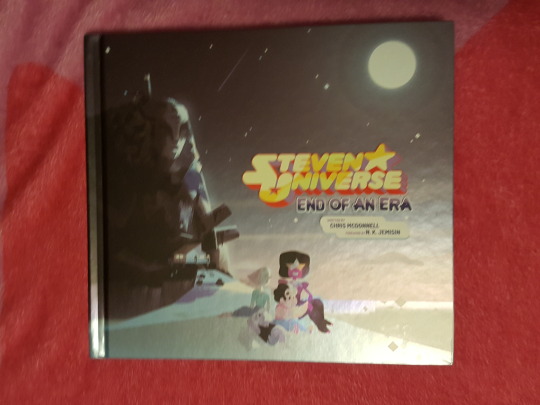
Like the previous concept art book, Art and Origins, I'll be giving you a description of the structure and overview, while also collecting notable information for fans. Obviously just about everything is "notable" once again, but I'll aim for unique insight or perspective on the main source material, keeping the screaming about everything new to a minimum so you can also enjoy something for yourself if you pick it up. My low-quality photos should prevent people from feeling like I'm reproducing the book in any capacity. Please grab one while you can and have your own experience!
[SU Book and Comic Reviews]
OVERVIEW
The book is titled "End of an Era" for a couple reasons--obviously because it is released after the show has wrapped, but also because Gem history recently ended its "Era 2" and began Era 3--an age of prosperity and peace. The author--the person in charge of adapting all of this information into this slick, readable package--is Chris McDonnell, whose work was previously applied on the Art and Origins book.
The foreword is by N.K. Jemisin, a well-known science fiction author who's a huge fan of the show (and wrote a really excellent series that also has a weird geological connection, by the way).
And the cover, like its predecessor, is shiny and decorated with a beach scene featuring minimalistic characters--this time it's the Gems at night in front of the Temple, and on the back cover is a big pink leg ship in a cross-legged pose.
The interior covers are decorated with tons of amazing sketches of Steven and Connie on the front, and a bunch of Gem sketches on the back. Every interior page that most would leave blank is highlighted with some kind of sketch art or character exercise--it's so much to look at, so much to absorb.
The book is dedicated "For Eddie."
Its organization is different from the previous book in that it shares applicable work in chunks associated with groups of episodes rather than pertaining to different aspects of building the show.
FOREWORD
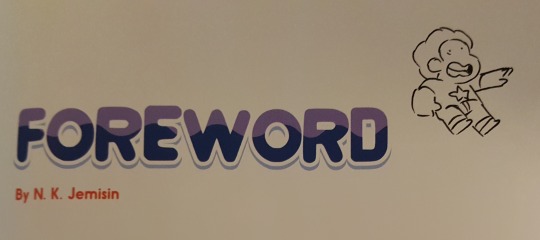
N.K. Jemisin gives us such a great introduction to the book--apparently understanding very well that the audience of this book is full of animation enthusiasts and adult fans more than it is full of kids, and explaining that bewildering journey some adults had from blowing this show off as a silly kid thing to falling in love with it hard and fast.
The important thing, Jemisin says, is being able to trust a storyteller with your heart. And it was clear to her that Rebecca Sugar knew what she was talking about and was saying important things about identity and the radical power that comes with accepting it and demanding respect.
Important also is how we handle heroes and who gets to be one in fantasy. That's part of the reason Steven Universe speaks to so many--because we see ourselves here, and know stories can be about us. Acknowledging the power we all have to MAKE THINGS BETTER with what we fight for is so important--especially if we're going to speaking to the next generation about it.
Highlighting Rose Quartz as a "born leader" who failed and Steven as a relatable scamp who did what she couldn't, Jemisin asserts that we can save the world.
1. END OF AN ERA
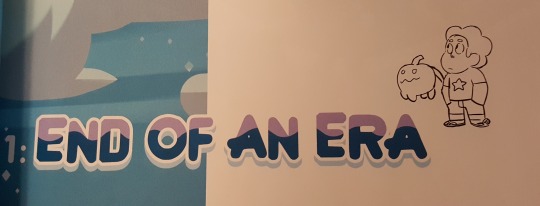
We start with an appeal to the audience to think about identity and the formative parts of our childhood--and how different it is if who you are and who you become is restricted, mocked, erased, or Not Allowed. Most people, if not ALL people, can relate to this, but for those of us with a special relationship with Steven Universe because of queer identity, this hits hard.
But it doesn't have to be anything grand to be something we respect--this show's authenticity comes largely from how personal everything is, drawn from real-life experiences and incidental truths from each artist's perspective, leaning hard on childhood and formative experiences.
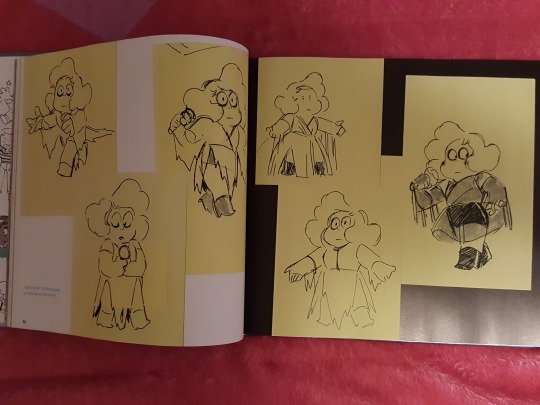
Rebecca Sugar offers some interview bits to discuss writing philosophy and why "writing female characters" was difficult for a nonbinary person who'd been socialized as a girl and a woman. Rebecca has spoken before about how frustrating it is that marketing for cartoons was SO gendered when she was growing up (and to some extent still is).
The Gems in the story are all "she/her," but on their planet they're defined by their work, not by emotion or relationships (unlike women in our society), so having them be socialized opposite to how she was and be able to claim those emotions through choice and NOT as just an expectation "as women" was revolutionary. Rebecca wants her show to tell all marginalized people that they don't deserve to be in the margins.

Weighing in on other aspects of the show were Ian Jones-Quartey, Joe Johnston, and Miki Brewster. Ian describes feeling like at first doing SU was a thrill ride that meant they'd finally get to do all the cool stuff, but it quickly became a responsibility that he took very seriously--the need to tell a good story now that he'd been given a megaphone.
Promotional art, planning documents, character sketches, and concept art from the lighthearted to the stone serious is included, along with some very cool (sort of famous) timeline charts that track major characters' developments. It's emphasized by Rebecca that the developmental materials ARE NOT CANON (and especially are not MORE canon) compared the final show.

There are concept sketches alongside final art for Aquamarine and Topaz in "Wanted" (with Topaz labeled "Imperial Topaz"), the Zircons in "The Trial," Blue and Yellow Diamond, and the Off Colors (including Pink Lars).
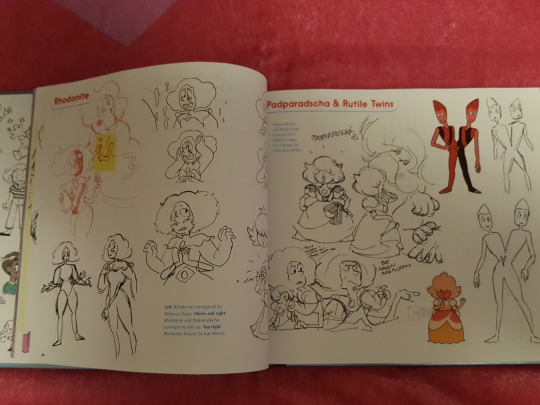
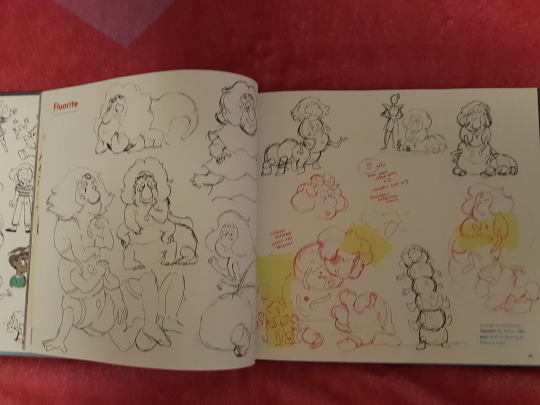
And there's also a spread of "the two sides of Steven's life: Gem Magic and Rock N Roll" featuring Sadie Killer and the Suspects (referred to as "Buck's band")--as well as a cool "Crew Cameos" key and some concepts for short-haired Connie.
And then there's some more "finished" art with stills alongside concepts, including some background art, revision, and really cool "fairytale" art from some of the shadowplay storytelling bits. We get "Lars of the Stars," "Jungle Moon," and "Can't Go Back."
2. THE BEGINNING OF THE END: A SINGLE PALE ROSE

In discussing the huge reveals and Gem mysteries in the show, the pacing is examined, and emphasis is put on the intended "slow burn." One of the most difficult things in the show was to strategize so that every piece that was needed to support another piece in the future was placed properly to seed what it was supposed to.
Some of the ideas they developed were more of a group effort and were fit together collaboratively (like Amethyst's being younger than the other Gems and Jasper being from Earth), while others were intended from the beginning based on Rebecca's vision (the fundamental idea of Pink Diamond's true identity, for instance, as well as Obsidian's design and sword and our Pearl not being Pink's first).

The writing process gets a great deep dive here, including fun tidbits like how the orb in the moon base was inserted by Joe Johnston and they literally had no idea what it was for when they wrote the episode. They repurposed it when they figured out what they needed.
Rebecca credits her detailed timelines for helping keep the order straight, and discusses how other artists are sometimes flabbergasted that a storyboard-driven show can have this much detail and continuity and yet not get wrecked by the free non-scripted boarding process. But Rebecca and the Crew valued that approach and loved the way fresh eyes would handle an idea, making it come back alive, entertaining, vivid.
Several Crew members weigh in on the writing process. Lauren Hecht refers to making lots of incorrect guesses despite being on the inside. Joe Johnston recalled getting briefed on his first day and getting so excited to start working on this massive project.
Miki Brewster remembered being told Rose Quartz is Pink Diamond and being shocked--and also confused about why Ruby and Sapphire would need to be married if they're already basically married. Drew Green talks about being brought in late and getting to watch unaired episodes and a rough of the movie while eating cereal.
Ian Jones-Quartey complains about Pink Diamond's real jester-like form being leaked to the internet through a Hot Topic shirt. Rebecca piggybacks on that and says it was upsetting that the wedding was leaked because of toy fair keychains featuring Ruby and Sapphire in wedding attire. They'd always be worried about leaks, and sometimes Rebecca struggled not to talk about the reality of Pink Diamond before the reveal because she knew it would make so much more sense once the truth was out. And everything associated with Rose makes more sense once you know she's Pink--especially what happened with Bismuth, considering what we know about how Pink Diamond has a habit of treating anyone who no longer serves her interests.
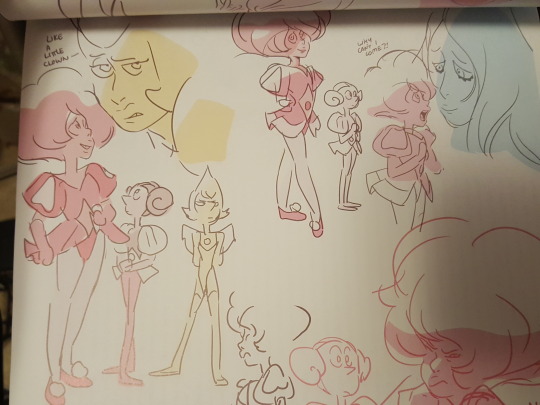
When it comes to visual cues, Rebecca also talks about intentional designs to create a feeling of unity between concepts, like the flower shapes on Pink Diamond's palanquin lining up with the poofs of Steven's hair and the star imagery of the series. Steven Sugar and Mary Nash discuss how the Human Zoo incorporated this imagery, trying to look like Homeworld with a Pink Diamond touch.
Steven Sugar, as a game nerd, liked to throw in video game references from old and modern stuff to feel like he's inserting what he's enjoying and who he is from moment to moment, while Mary Nash, who related to Sadie as a basement-dwelling young person with cult interests, liked to include stuff from MST3K and cult movies. Pearl's hand gestures get a spotlight too--her reflex to cover her mouth when Pink Diamond was being discussed was analyzed here.
A "Top Secret Visual Timeline" from 2016 is included which tells us some Diamond history. It has an earlier version of Pink Pearl's fate and does not include Spinel since the movie hadn't been greenlit. The timeline includes the birth of the Diamonds, the emergence and major story beats for each major character, and some philosophy of the driving force behind each.
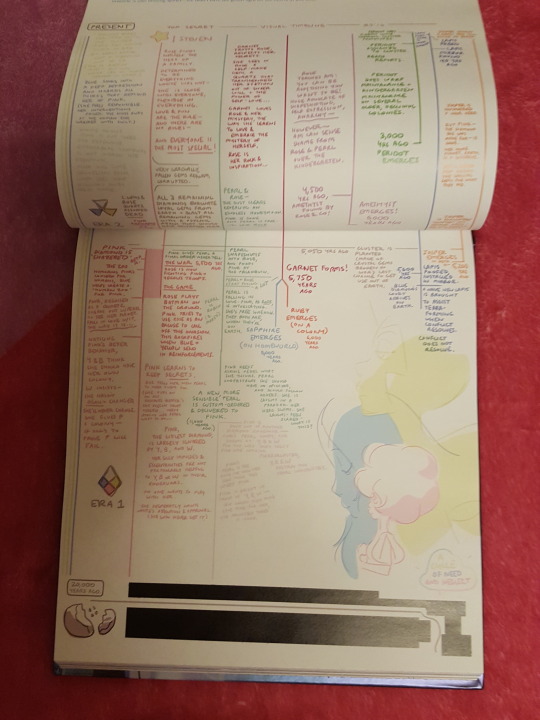
We're told that Pink Diamond straightened up, behavior-wise, after she lost her first Pearl, and that Yellow and Blue wanted to give her a planet but White only agreed to it to prove she would fail at managing a colony. Pearl, meanwhile, is so confused to have a Diamond who keeps asking her what she thinks when she doesn't believe she should have opinions.
And when Pink moonlighted as Rose to start conflict, she found herself leading an army to fight Pink's troops--then Yellow's, and eventually Blue's too. Lapis is said to be waiting for the conflict to end on Earth so she can terraform, but she gets trapped instead.
Pearl's love story with Rose is described as "an endless honeymoon" where she's free to love her, while Rose's is more like "I'm now the head of the family and I'm going to give everyone what they never had, so everyone is super special!"
Jasper is described as "adopted" into Yellow's army as the only successful Beta Quartz. And White Diamond knew that Pink Diamond was not dead--she thought she was just running away from home like a brat and would eventually be back.
3. THE HEART OF THE CRYSTAL GEMS
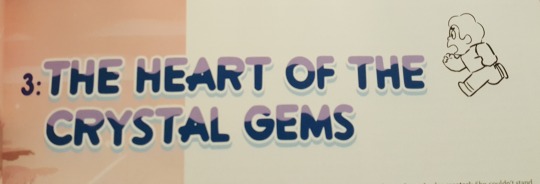
Now we discuss Rose Quartz--the original Pink Diamond. How she was selfish and selfless, never enough and always too much, and how Greg was her first partner who "challenged her" to be an equal. Rebecca describes Rose as being delighted by the idea that both she and Greg reinvented themselves, but when that leads her to want to share her past, Greg isn't interested--he only wants to know who she is now, and doesn't consider the old her to be her.
Rebecca likes Carl Jung's concept of "enantiodromia," which is the idea that extremes lead to their extreme opposite. This is demonstrated in all of the Diamonds. This narrative is interspersed with drawings of Greg and Rose being cute.
But another "heart" of the Crystal Gems is its relationships--particularly, Garnet, the fairy tale romance embodied. More psychological theories are discussed with regard to differentiation in a relationship making the relationship stronger, and how they made sure that happened for Garnet during the appropriate arc. Rebecca has struggled with the idea that she, like Ruby, went straight from a "family" group to a living-with-others situation and never lived by herself. But she also learned that you can in fact develop as a person in the context of a relationship--you don't have to be alone to do it. Ruby learned that too, and chose on her own terms to be with Sapphire.

The wedding made so much sense to Rebecca and the crew that they couldn't imagine a wholesome couple like Ruby and Sapphire not having a wedding episode. They wanted it for years: The wedding concepts always included the tuxedo for Sapphire and the wedding dress for Ruby.
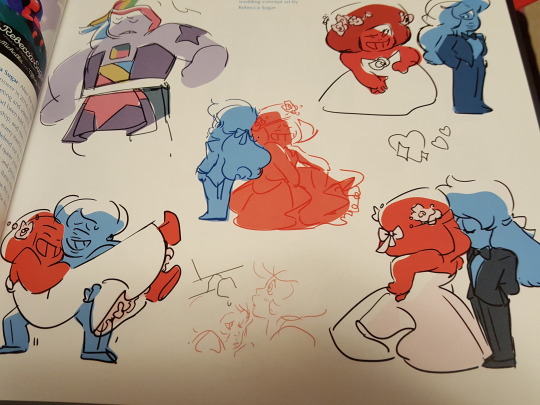
But pushback (often blamed on the conservative standards of the international market) led to negotiations trying to keep Ruby and Sapphire's relationship from being explicit. Rebecca and the Crew were very tired of this double standard, and they were especially irritated by attempts to claim a wedding wouldn't be well received by a core demographic or wouldn't make sense for Steven's character. But other shows had done weddings and Steven had been established to love weddings already.
Rebecca kept adding more elements to the wedding episode to answer all the concerns, but she didn't want to back down from explicit marriage between these characters. They deserved it. And the audience deserved to see this as wholesome, like any other cartoon wedding. Eventually they got their way and were allowed to have the wedding. But the ordered episodes were also coming to a close without promise of more, so Rebecca had to request more episodes to be able to wrap up the storyline!
And of course, there is Steven, the true heart of the team. A very interesting aside discusses Garnet's leadership and how the network pushed the Crewniverse to acknowledge Steven as the leader. This was successfully resisted throughout as well--because Garnet is the leader (unless she's incapacitated, of course). It's fantastic that this concept was preserved because too often a young male chosen one is elevated above people with more experience and knowledge because of that chosen one tradition, so it's really nice to have a show acknowledge that team leadership is more appropriate for an adult.
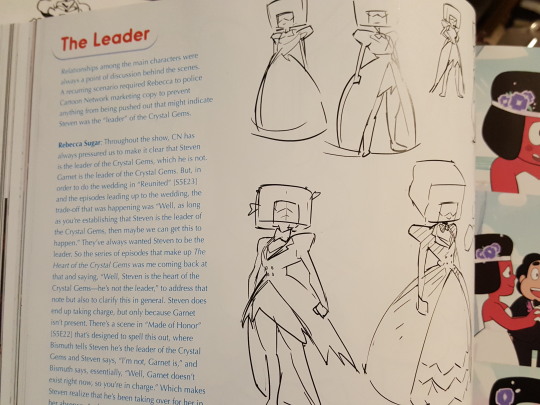
4. ERA 3
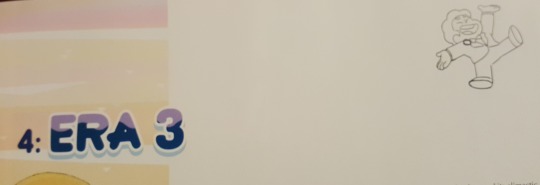
Beginning with a discussion of the Diamonds, this chapter deconstructs the dysfunctional "family" of the Diamonds (who are said to be based on tropes about evil stepmothers and stepsisters), with the thread of dysfunction originating with White Diamond.
Yellow is physical, Blue is emotional, White is judgmental, and Pink is impulsive. Some philosophy on why Pink is naturally manipulative and why she clashes so much with White is offered.
White believes her identity is to be imposed on all because she is the pinnacle of what should be--and therefore, she has the right to make decisions and statements about and on behalf of everyone. But her secret is that she can't do what the others do--act or feel or want. In trying to be everyone, she is no one.
And this becomes very important when she confronts Steven about his identity and turns out to be wrong. The triumph of Steven being totally, fully himself is a beautiful, simple revelation that's described as far more satisfying than the theories about Pink living inside him or Rose returning from his Gem.
Also discussed is Gem architecture. A lot went into this idea, and Steven Sugar weighs in to say he had to think of what it would mean for a world to have buildings but serve no human needs. That's why it's mostly focused on transport and storage. Even the broken planet is meant to indicate a place stripped for its resources, and everything serves a function that is meant to avoid looking like the human equivalents.
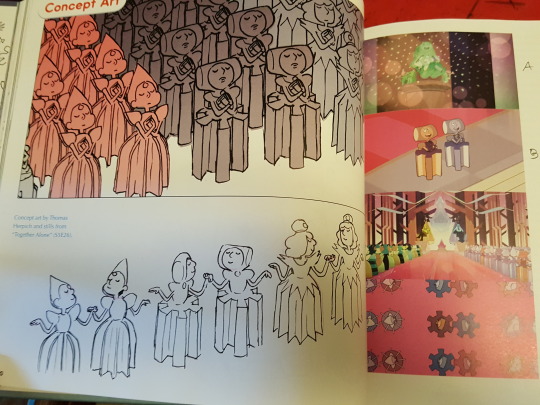
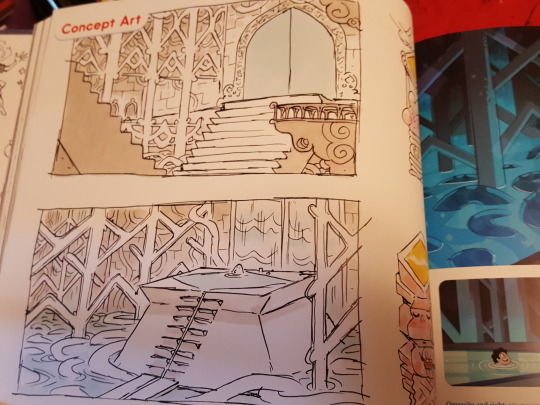
And there's another layer, too: a difference between Era 1 and Era 2. Era 2 became more functional to hide Era 1's broken bits, and older Homeworld buildings still have some "ornate and ancient" feel to them. And the fact that props, tools, and even walls and doors could be living was taken from a concept Rebecca thought was horrible from old Busby Berkeley movies, where people were inanimate objects and it was portrayed as lovely. Tom Herpich helped conceptualize these living objects.
Steven dealing with "princess tropes" is discussed here too. The Pebbles (worked on with Pendleton Ward) were sort of his Cinderella's mice, and all the locked-in-a-tower, having supportive tiny friends help you, getting princess clothes made, attending a ball, having to mind your manners stuff was intentionally related to fairy tales.
The point of doing that (besides fun) was to easily invoke the feeling that Steven was being made to be someone he's not, and that he was being treated like THIS is who he really is when it isn't. White Diamond as the "evil stepmother" is discussed with regard to her detailed features and massive scale. They generally didn't put fingernails and eyelashes on characters (especially not to indicate that they were women or girls!), but they decided White would get all of these feminine markers for tradition's sake.
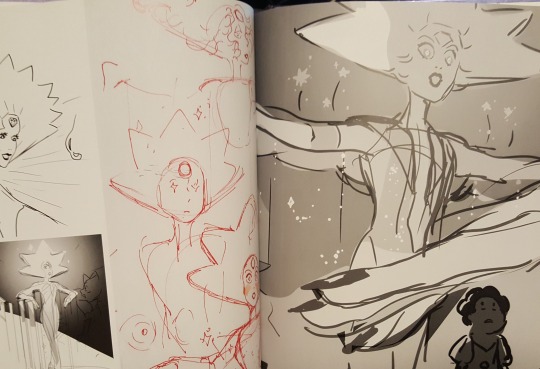
Rebecca also invokes several other references that were included and describes the princess tropes as "chipping away at his integrity" setting him up for the final challenge with White.
There is again tons of concept art: Homeworld architecture, Pebbles, Diamond diagrams, background Jades and Lemon Jade Fusion, Comby, Diamond extraction chambers, and White Diamond.
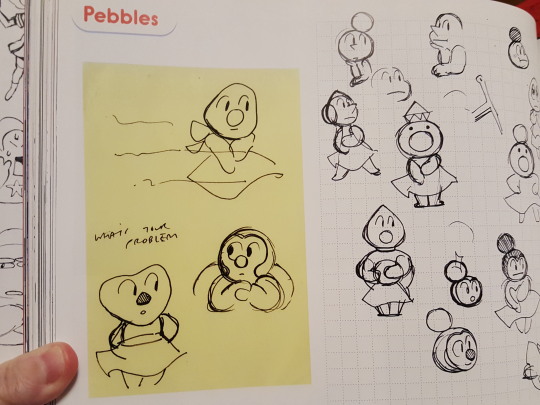
5. CHANGE YOUR MIND

Now we finally begin to discuss Steven's identity. The "Perfect Steven," discussed in several interviews before this book's release, was an idea back in 2013; the "ultimate Steven," beefed up and shonen-looking, was far from perfect because OUR Steven is perfect, while this alpha hero Steven idea (used in Steven Universe Future) didn't belong being idolized in such a show.
They thought about having Steven fall apart into organic half and Gem half early in the show (during "Giant Woman" after a successful fusion and unfusion, even!), but they didn't try the concept until the last episode. They didn't want the "Pink" Steven to be portrayed as "better" even though he would be more powerful, so they decided he isn't whole without his organic self and he's just as much of a shell as the organic half. They absolutely did not want any ending that required Rose to be inside him or waiting to come back. But the debates were fierce--what DOES it mean to have Rose's Gem?
Ian Jones-Quartey brings in an anecdote about his own family to emphasize some of the immigrant themes that inspired aspects of the show. He had a brother who reinvented himself elsewhere away from family without resolving issues, and all the ramifications of that were explored in the show through Rose Quartz. (He is careful to say he doesn't think his immigrant experience is like being from another planet!) But he did say you can hurt your old family even if they were toxic or didn't know the real you, and you can hurt your new family by hiding your past. The Pizza family of course was also a more direct reference to Ian's Ghanaian family.
In talking about the new Fusions from this episode, Sunstone is largely described by Miki, who also got to board the Sunstone section. Sunstone was described as a cool 1990s character and the evolution just continued into making them a fourth-wall-breaking PSA dispenser. Obsidian is also discussed, with their sword being an early concept. Steven Sugar said they totally knew it would be forged in action. Obsidian being similar to the Temple design is of course another very early detail.
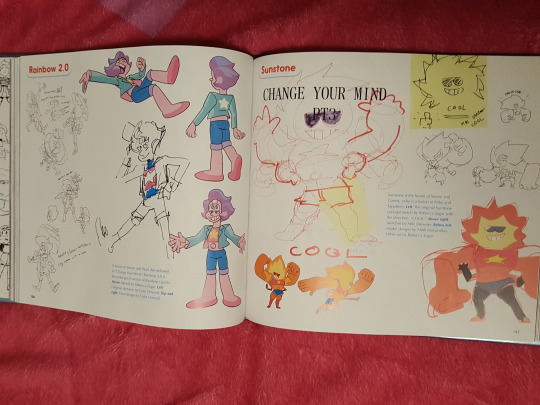
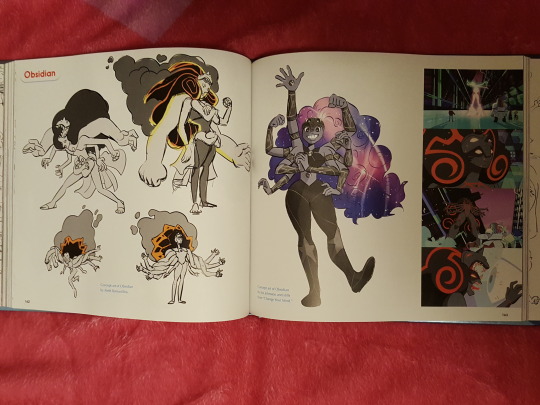
The story of how James Baxter got involved with one of the final scenes (Organic Steven and Pink Steven fusing in front of White Diamond) was shared. His family was fans of the show and Rebecca Sugar took the time to drive to a birthday party for his daughter and give her a drawing. He then owed her a favor, and this was it.
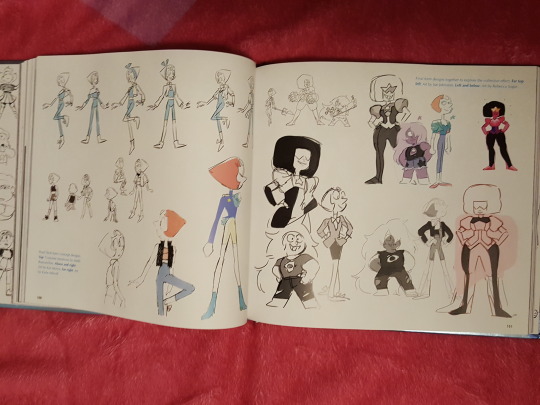
Concept art is again included, this time with sample boards, promo images, a Diamond fight concept, costume design changes for the Gems, new Fusions, the so-called "Mega Diamond" ship conglomerate, some scenes from the White Diamond confrontation, Pink Steven, multiple pages of James Baxter animation, corrupted Gems and their healed selves, and photos from the "Change Your Mind" premiere and some awards. The show has won one design-related Emmy, a Peabody Award, and a GLAAD award.
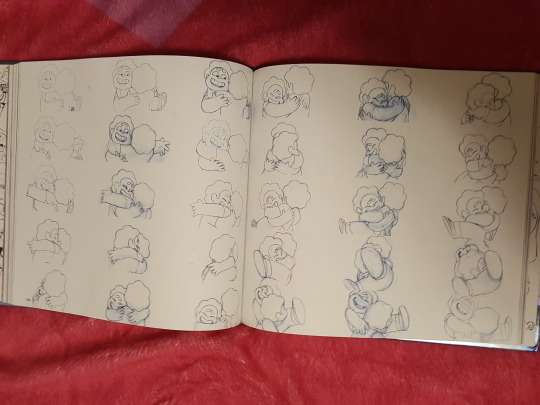
6. STEVEN UNIVERSE FUTURE
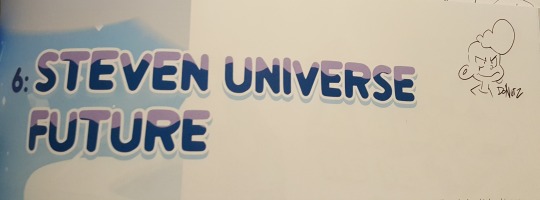
The book doesn't cover the movie because it got its own book, but dives right into Future. Ian Jones-Quartey emphasizes that the movie and Future are separate and different from the original show, which ENDED. After all, after that, Steven has a neck!
Some new names are invoked now: new writers Kate Tsang, Jack Pendarvis, and Taneka Stotts. They were excited to have Steven make HIS OWN mistakes instead of trying to clean up someone else's! Now, instead of doing the usual shonen anime thing and having the final battle be a big physical rumble, Steven has to make peace with himself and take an active role in coping with what all the fighting has done to him and what effect it's had on who he is (and who he wants to be). There is no sudden "I love myself!" answer, either. It's always a process.
Drew Green and Maya Petersen, who came on board as storyboarders officially in Future, also weighed in on writing for a "mature" show, how to deal with Steven being a "moral compass" while being sort of unreliable, and what they learned as Crew that they didn't know as fans. Drew didn't know Garnet never asks questions. Jack didn't realize the show never deviated from Steven's point of view. Taneka was nervous but excited to collaborate. Kate was worried about how established the show was and what to do as a new writer to contribute appropriately.
Maya was on the old Crew but not as a storyboarder, so felt like some of the "old" ideas ended up not being appropriate for the "new" Future in an embarrassing way--and dreaded the idea of dealing with Steven's emotional problems when they were similar to stuff she'd been through. She also was personally behind the idea of Steven wanting to dump his problems by becoming Stevonnie, and got to work with Etienne Guignard on inventing the Pearl creation backstory with Volleyball.
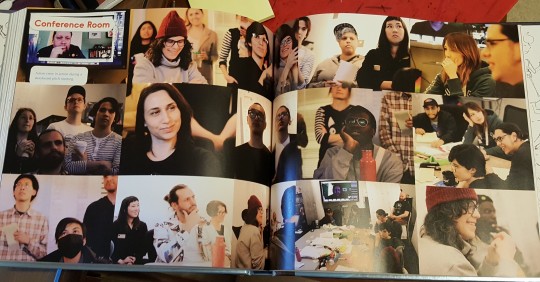
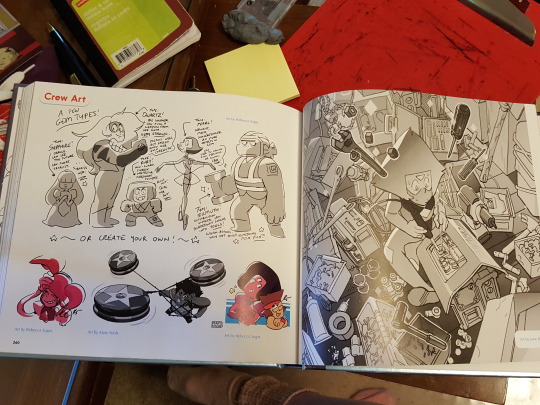
There's some discussion of "depression hobbies," stress, and the show's pacing. And they say Etienne was entertaining at pitches. There's even some discussion of how Greg is taken off a bit of a pedestal because his terrible restrictive life in the suburbs sounded wholesome to Steven and Greg presented it negatively.
And then there is some information about how the Crew felt behind the scenes due to fan reactions and negative press. Ian discusses feeling offended when the Black characters are described as bad examples, as if their cartoonized but realistic-in-context features are automatically caricatures.
Rebecca Sugar felt beaten down by some of these narratives and began to access mental health services, inspiring some of the content of "Mindful Education." A long reflection from Rebecca discusses people's infighting about her show and what she had a responsibility to show or not show in the story. She learned a lot about bullying from Cartoon Network's anti-bullying program and learned that bullies thrive on whatever attention you give them--unless it is made clear to them by a peer group that no one is impressed by their cruel actions. Also, not all negative feedback is bullying. Constructive criticism is different. Self-awareness can help you avoid internalizing what bullies might do or say to you.
Segueing from the discussion of how people are affected by and connect with the show, we then discuss how they chose as a team what should be covered as the show came to a close. They didn't have time to do quite a few stories they wanted time for, like a Rhodonite story, a Lars side story, and Diamond "prehistory" and religion; all of it was put aside for the main arc with Steven.
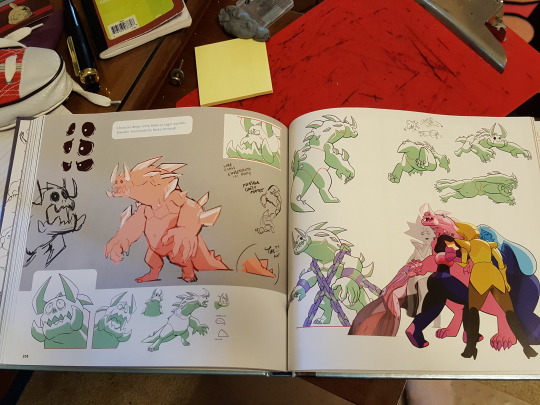
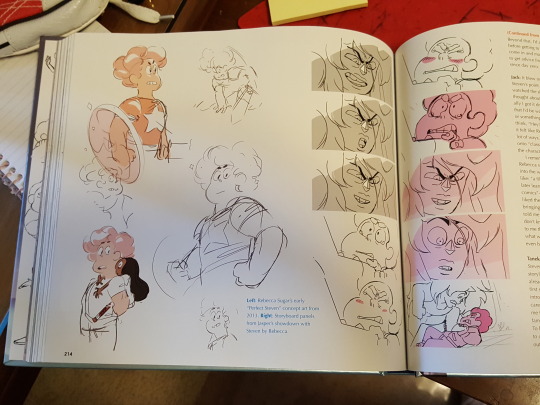
They thought people would find those stories about Homeworld and Off Color history very interesting, but so much of the show had been about Steven's Gem adventures, so keeping him mostly on Earth seemed appropriate. The acknowledgment of his battle damage, of his trauma, was necessary and real, and helpful in an important way to the core audience.
Oh, and there was some stuff about a cheeseburger tree. Don't ask.
In discussing the "reverse escapism" of the original show (Gem aliens are intrigued by everyday human culture, and realism is necessary), Rebecca says her views have changed on escapism and gets why some people want a soothing feel-better show. She acknowledged also that her own escapist dreams-come-true fulfilled in the show didn't feel like escapism because they were givens to the majority of mainstream culture, but were never guaranteed to marginalized people.
Rebecca ties in her several-times-told story about "Love Like You" and how the middle bit was when she didn't feel she was worth looking up to, and the realizations she had to tie the beginning to the end. Feeling like someone will like you less if they know you more is terrible. So sometimes a show like this can be helpful in telling people that they belong when their fantasies are things like "I want to be loved" and "I want to know I exist."
In Future, Steven has to connect to who he is and love that person--and understand that person enough to finally feel that even if he's not fixing their problems or saving their world right this second, Steven deserves his family's love and support, and they WANT to give it to him.
There's a huge amount of supplemental material in this section so there's no way I could name it all. The charts for Future's timeline are pretty straightforward, though a few episodes like "A Very Special Episode," "Why So Blue," "In Dreams," and "Bismuth Casual" aren't specifically represented and a couple are in a different order ("Prickly Pair" was conceived as happening after "Fragments" and "Homeworld Bound").
Steven feeling like a monster, having intrusive thoughts, having not forgiven the Diamonds, and getting help/moving on--it's all there.

We have keys, color scripts, and boards for the new opening and some various backgrounds and storyboard art from episodes. Model sheets for Shep, Nice Lapis and Mean Lapis, Jasper, Steven Tag Gems, Pink Steven Powers, Monster Steven. New house concepts, Era 3 Homeworld concept art for the Diamond environments, and background art for the Reef.
New Connie and Greg designs. Concepts for Mega Pearl, the Rose Quartzes, Bluebird, and Morganite (who didn't get used). And there are some photos from recording and the conference room. There are even some extras from "Crossover Nexus," the crossover with OK K.O.!--including an unused cut scene that included Ruby and Sapphire fighting. The rest of the book is a bunch of adorable Crewniverse art--extras, blog drawings, promos, and gifts to each other.
NOTABLE
1.
The first timeline chart in the book features a cool sketch of the original Off Colors, which at the time this planning document was drafted included unused Off Colors Flint and Chert.
We knew of their existence already because of an episode of the podcast, but these two unexpectedly appeared as incidental characters in the Steven Universe Future episode "Homeworld Bound," identified only in the credits. Sad to think that instead of banding with the Off Colors, these two were probably shattered for their crime (being Quartzes who don't want to fight) and that's why we see them being repaired in this episode. Later, there's some brainstorming for types of Off Colors and "a Ruby that wants to wear limb enhancers" is mentioned as well.
2.
It looks like there was also originally more juice to the story of tracking down the events of the war culminating in Pink Diamond's assassination.
One of the timelines talks about Steven thinking it makes sense that Pearl can't talk about her involvement because she might have been a double agent, explaining why Rose Quartz always knew what Pink Diamond was doing. It seems like that bit was supposed to be included in Garnet's version of the story she believed in "Your Mother and Mine." Seems like they originally conceived Garnet's story to inspire the Off Colors to become pirates and freedom fighters, though in the show's canon this storytelling happened after Lars had already reinvented himself the way he did.
Sadie was also supposed to be sending letters to Lars via Steven, which is funny since the "Letters to Lars" episode is just a montage Steven letter. And of course it's specified that Steven was supposed to get Pink Diamond flashbacks by going to the Palace on Homeworld.
3.
The second chart in the book makes references to Sadie's reinvention of herself as a parallel to Lars, Greg, and Pink Diamond all doing the same thing, and how positive it is to embrace such a thing--a version of yourself that YOU create.
I love that Yellow Diamond's arm ship arm-wrestling the Cluster was always part of the plan.
There's some more explicit direction to have Connie help Steven understand the Diamonds as "strict parents," and a lot more emphasis on everyone realizing Rose had been inspired by THEM rather than them all following her.
White Diamond is presented here as if she thinks of Pink Diamond as a "daughter" (whom she now understands she has "lost"). There are notes on how the Diamonds have a responsibility to their children and should attend to it before just continuing to make more.
4.
One of the concept art images for the Off Colors features Rhodonite crouching by Padparadscha saying "Don't worry, I won't let them hurt you." It's very interesting because she DOES seem to protect Padparadscha in the show, but doesn't seem confident about it in her final version, even though it does seem like she'd be "programmed" to guard aristocratic Gems because of her Ruby and Pearl makeup. Cool.
5.
A "Crew Cameos" spread was included, which is of great interest to some of us who loved seeing the Crew insert themselves into the show. Not every SU Crew person who's been represented in a crowd was there, but this crowd included Amish Kumar, Kat Morris, Amanda Winterstein, Angie Wang, Lamar Abrams, Emily Walus, Mary Nash, Joe Johnston, Christy Cohen, Danny Cragg, Hilary Florido, Danny Hynes, Matt Burnett, Ben Levin, Elle Michalka.

6.
The official national flower of South Korea, Hibiscus syriacus, is the name of Pink Diamond's flower.
7.
One of Steven Sugar's comments about the silhouette difference between humans and Gems points out that humans have ears. This seems to be pretty good confirmation that they are not supposed to have ears, despite that sometimes we'll see ears drawn on them in some frames.
8.
Rose Quartz/Pink Diamond is characterized in this book as "self-hating" in a really interesting way, saying that because she believed she was not capable of compassion, she practically worshiped those who demonstrated that ability and thought they were so much better than her--which is described as "intoxicating" and resulted in others being drawn to her. How interesting is that!
9.
Timelines reveal that early plans for Pink Diamond's first Pearl originally had her getting destroyed by Pink during a game, and then her destruction was rewritten as a punishment from the Diamonds after Pink Pearl defended Pink Diamond to the other Diamonds. They went back to the idea of her getting hurt by Pink for the final version, though the cracked face and control by White Diamond was not on the agenda until they started writing "Change Your Mind."
10.
The approximate ages of the major characters, based on emergence, are revealed on these timelines. It begins with a cracked-planet-looking graphic depicting four tiny Diamonds emerging at 20,000 years ago. Some suspicious "blacked out" redacting surrounds a long timeline tail that goes back before that, which may mean there are secrets they still don't want to reveal. But the dates go like this:
20,000 years ago: The Diamonds emerge.
11,000 years ago: Pearl is custom-made for Pink Diamond.
8,000 years ago: Sapphire emerges (on Homeworld).
6,000 years ago: Ruby emerges (on a colony).
5,750 years ago: Garnet is formed.
5,600 years ago: Lapis is poofed and put in the mirror.
5,200 years ago: Jasper emerges (on Earth).
5,050 years ago: The Cluster is planted.
5,000 years ago: Amethyst emerges (on Earth).
4,500 years ago: The Crystal Gems found Amethyst.
3,000 years ago: Peridot emerges (on Homeworld).
40 years ago: Pearl found Lapis's mirror at the Galaxy Warp.
And of course we know 14 years ago Steven is born!
11.
Originally the Diamonds were based on a quartet of themes: Love, Fear, Pride, and Sorrow. It got too complicated to keep and it was abandoned, with Pink's identification of "love" being described as "particularly outdated."
12.
Notes on a sketch say that Pearl was inspired to become bold and unashamed because Pink's questions drove her to have opinions, and it's said that Rose "fell in love" with her boldness.
13.
Rebecca tells the story of driving off a ridge and getting stuck in the desert, comparing this to Ruby's tumble during her Wild West adventure and using it as inspiration. She's told this story before but here it is in print. She also included the story about using the flowers from a friend's wedding to put in Ruby's hair.
14.
Rebecca describes having to "fight" notes she was given when it had to do with Ruby and Sapphire's relationship. One she describes as NOT fighting was for a signing card depicting Ruby and Sapphire dancing. It was called "too romantic" and she decided not to worry about it since it wasn't the actual show content.
She was also scolded over her book The Answer because the powers that be expected her to downplay that relationship. She always argued that queer youth deserved these things.

15.
Tom Herpich describes being inspired to name Blue Diamond's comb "Comby" because he was watching the news about Comey getting fired from the FBI. It's also a mineral-related term and I always assumed that reference was intentional, but maybe it's not and this is the only intended significance to Comby's name?
16.
Rainbow Quartz 2.0's design is not discussed, though the other two new Fusions from "Change Your Mind" (Sunstone and Obsidian) were. RQ2 has some sketches included, but no accompanying narrative in the text.
17.
A sheet of corrupted Gems and their healed selves is offered, though it doesn't appear to be final. The obelisk in "Serious Steven" is labeled Albite. The unnamed Worm Monster, Desert Glass, and Watermelon Tourmaline are included. An unnamed birdlike Gem represents the Big Bird monster from "Giant Woman." The crab monster from "Arcade Mania" is labeled Blue Chalcedony. The Tongue Monster is drawn uncorrupted but not named. The Flower Monster from "Back to the Kindergarten" is labeled Grossular Diopside or Titanite. The invisible monster from "Island Adventure" is labeled Moonstone. The Lighthouse Gem is labeled White Topaz. A form for Larimar that was used in "Change Your Mind" but changed in Future is there. The Slinker is listed as Chrysocolla. And the Crab Monster is listed as Aventurine.
On the next page, this is changed to Bixbite (as it was in Steven Universe Future), and we then also have Lace Amethyst, Blue Lace Agate, Crazy Lace Agate (Fusion), Ocean Jasper, the Mother Centipeetle Nephrite (Facet 413 Cabochon 12) and three other Nephrites, Angel Aura Quartz, a hooded Jasper, Zebra Jasper, Biggs Jasper, Watermelon Tourmaline (labeled as Fusion of Gem * Onion--huh?), Snowflake Obsidian, "Little" Larimar, and Orange Spodumene (who was the Worm).

18.
The Rhodonite side story would have been about the love story of a Ruby and a Pearl working for Morganite. Images of Morganite and her servants, unfused, are in the book. We do not get this additional information, but Rebecca said in a panel shortly before the book's release that Rhodonite's story would have been about finding out that she had been Rejuvenated 17 times because her components kept falling in love and needing to be reset.

19.
Referring to the Diamonds on one of the charts, Steven's perspective is "I can't believe I helped these" and then there's a censor bar. Welp.
20.
Some included art by Hilary Florido features Kevin with a souped-up Koala Princess car and another where Kevin is staring at himself in the mirror in front of an altar to himself.
21.
Rebecca's sweater collection is included in the Crew art.
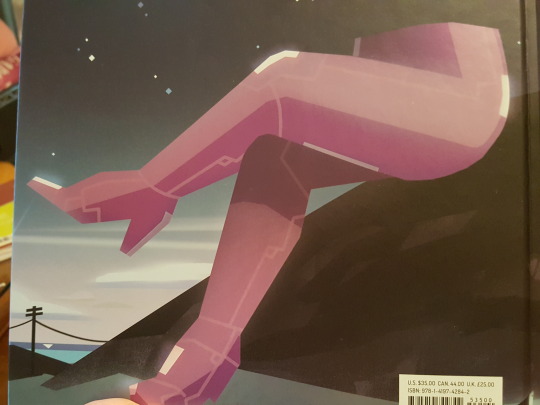
[SU Book and Comic Reviews]
140 notes
·
View notes
Text
I have said a Lot about the “Raph is a system” theory over the past several months, so this is something of a compilation post. It’s got some new stuff, it’s got some old stuff. (You’re reading Part 1) (Part 2 is here) (Part 3 is here)
---
Firstly, “system” is the term for someone with Dissociative Identity Disorder, or DID. (The term can also apply to some folks with OSDD.) Someone might develop DID after experiencing long-term trauma at an early age- roughly five or six years old. To paraphrase the DSM-V:
1. We’ve seen three (possibly four) distinct personality states who speak, act, and perceive others differently.
2. The personality states, or “alters”, don’t necessarily share memory, and Donnie insinuated in “The Clothes Don’t Make the Turtle” that Raph has a bad memory in general.
3. Problems arise when alters don’t get along or aren’t on the same page. That none of them seem to be quite aware they’re a system doesn’t help either; it’s hard to work on communication and cooperation when you don’t know they need to be worked on!
4. This whole situation isn’t a normal part of a broadly accepted cultural or religious practice, or just Raph playing make-believe. (Though I wonder if he had “imaginary friends” when he was younger...)
5. It’s also not because Raph’s been smoking the devil’s lettuce or whatever. “Pizza Puffs” was one long weed joke and he was the only one “sober” (not poisoned) throughout! We don’t see this happen to other mutants, so it’s not a bizarre side effect of mutagen either.
(I’ve seen a few people joke that Mikey has “multiple personalities”, but that’s a tad yikesy and also just plain incorrect. His “doctor” personas are something he does deliberately, and youngest siblings are just Like That.)
So yeah, Raph is pretty heavily DID-coded. We’ve seen four alters so far:
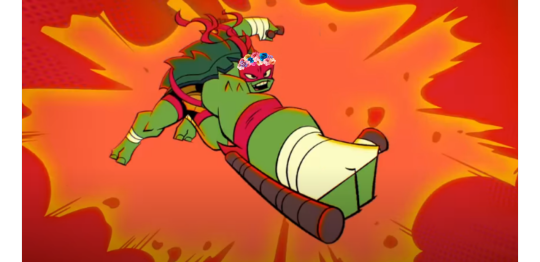
“Host” Raph (HR): He’s our everyday Raph. A “host” is an alter who fronts most of the time and takes care of “business as usual” situations. They are often unaware of past traumatic events, such that they can appear “normal”. (Ex: the host of a child who lives with an abusive parent could be unaware of the abuse. Otherwise, they might cry or be uncooperative whenever the parent is near, further invoking their wrath. This unawareness allows them to be a “good child”, and stay under the parent’s radar sometimes.) Some systems have more than one host, but that the others have shown up so rarely in this story suggests HR is the only host (for now?).

Savage Raph (SR): Debuting in “Man vs. Sewer”, he’s a survival-oriented alter. HR probably could have defeated the Sando Brothers on his own under normal circumstances, but being in the middle of a breakdown doesn’t do much for your fighting skills. SR got pulled to the front to deal with them instead.

“Red” Raph (RR): “Red” is just a placeholder since we don’t actually know his name yet (or even if he has one, not all alters do), though I’ve also heard folks call him “Angel”. He’s got a “tough love” approach to problem-solving, which was probably a helpful thing in the past. LDM were no doubt rowdy children! We were (officially) introduced to him in “Pizza Puffs”.

Mind Raph (MR): MR could just be a manifestation of HR's thought process via Cartoon Goofery, but that possibility doesn’t give me anything to work with so I’m ignoring it. He’s pretty similar to HR, maybe a tad more upbeat. We (officially) met him in “Raph’s Ride-Along”.
When “Pizza Puffs” first aired, I was like “ah yes, this is the alter who has the cranky edgelord tendencies we’ve seen in previous iterations of Raph. He probably broods on rooftops in the rain when he’s in a bad mood.” Combining that with the whole “Red Angel” thing gives off some Batman vibes. And, of course, SR is similar to the Hulk. Those two heroes are pretty different, but they do have one major thing in common...

A sudden, violent loss. Given how prevalent rushing water is throughout “Man vs. Sewer”, I’m thinking a flood came through and separated Raph from his family. (You could probably argue that turbulent water symbolizes a turbulent subconscious? 🤷) Again, DID stems from long-term trauma, so Raph must have been gone for... a while. A couple of months, maybe more? It’s hard to say exactly; we have a little wiggle room when applying human developmental psychology to a human/turtle mutant. Since Splinter still needed to care for the other three, he wouldn’t have been able to devote much time to searching for Raph, and the New York City sewers go on for miles and miles. The longer Raph was alone, the more convinced he would have been that the others had drowned and he was the only survivor.
How old would he have been? I know the turtles are “different ages”, but they were all mutated at the same time so I’m pretty sure Splinter was just like “the littlest one is the youngest, the biggest one is the oldest, and the medium-sized ones are the middle children.” They’re all probably fourteenish by “Finale”. Back in “MvS”, Leo said, “You know how savage Raph gets when he’s alone”. He didn’t say anything like, “You know how savage Raph gets when he’s alone ever since such-and-such an incident happened”. This suggests that LDM straight-up don’t know something traumatic happened to Raph; they were too little to retain concrete memories of that time. In their minds, Raph has always been like this. Draxum isn’t known for his patience, so even though he wasn’t able to immerse the hatchlings in mutagen for long, they probably mature a bit faster than humans. And since humans usually can’t remember anything from before four years of age, three sounds about right for the turtles, though they would have been stronger and steadier on their feet than any human toddler. I doubt Raph would have survived otherwise.
I think he’s sort of... “stuck” back in that trauma. Catching food, building a fire, making a weapon, and getting camouflage aren’t the behaviors of someone who’s only been gone for a few minutes.

When SR called for help, I don’t think he was expecting anyone to answer.
But Raph did manage to hang onto something as he was swept away! It wasn’t much, but that little ragdoll gave him comfort while he was scared and alone.
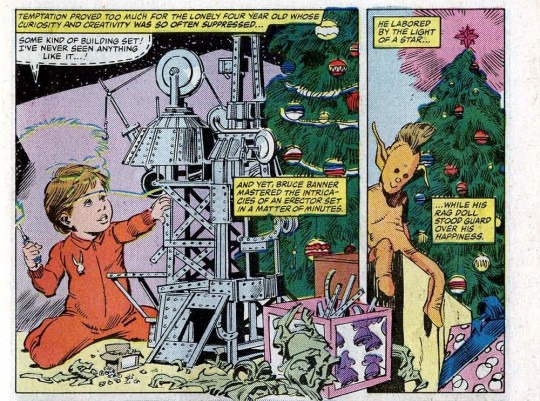
(The rabbit design on Bruce’s pajamas is probably a coincidence, but...)
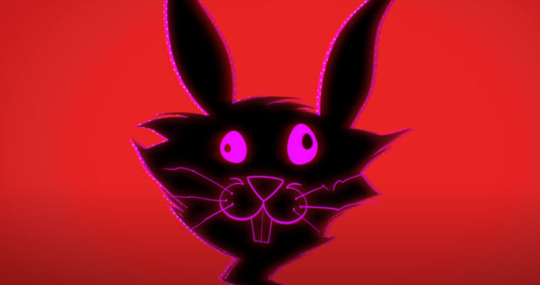
Raph seems the type to have sympathy for odd-looking toys. His knockoff Mrs. Cuddles plushie was the emotional crutch he needed back then.

And then he was separated from that as well. Lowkey associating Mrs. Cuddles with this traumatic event would explain why HR was so scared of her. That he doesn’t remember the trauma means he has no context for this fear, making it seem silly and baseless to him (and to the rest of his family), which is why he denied being scared at all in the first part of the “Mrs. Cuddles” episode. It would also explain why he collects teddy bears instead these days, they are a “safe” toy. (The moral of the story is to not make fun of triggers that seem silly.)
(I wonder what would happen if Mrs. Cuddles encountered Savage Raph? Perhaps he’d be quite sympathetic towards such a lonely little raggedy thing! Timestuck as he is, he probably wouldn’t question why a stuffed animal can talk... and it wouldn't be hard for her to persuade her “new bestest fwiend” to get rid of some “mean ol’ nasty sewew monstews” for her.)
That whole “sewer monsters” thing suggests Raph ran into... something while he was wandering alone. Y’all have heard those rumors about alligators living in the New York City sewers, right? Encountering Leatherhead could trigger a flashback.
It would be pretty easy to introduce Leatherhead into the narrative. One of the episodes the Rise crew had planned was titled “The Island of Dr. Noe”, and alligators have very impressive teeth. The Mirage comics had a story where Leatherhead and several cryptids were brought to an island to be hunted for sport.
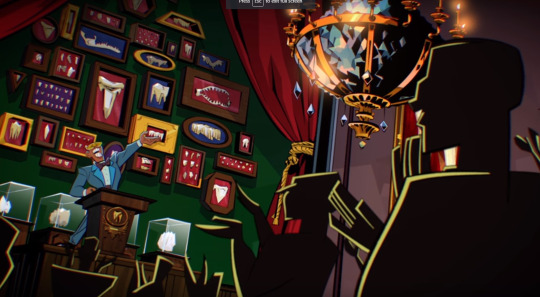
Noe seems to have quite a few cronies/friends/rivals he could entertain this way. Since he’s got that obsession with Raph, Noe captures him as well, knocking him out with those darts so he can’t waste his energy trying to escape too soon. (Let’s just assume everyone’s powers are glitchy because they all hit another wave of puberty, meaning they can’t just curbstomp the lower-level villains lol.)
HR wakes up on the island and, of course, starts to panic because he’s lost and alone. While wandering, he runs into Leatherhead, which would trigger a flashback to getting attacked by that alligator all those years ago. But Leatherhead doesn’t want to fight! He’s just as scared and confused as HR is, and could really use a partner to help him survive this island.
HR and SR come into conflict because Leatherhead is/isn’t/is/isn’t/is/isn’t a threat. HR eventually wins out, reasoning that even if Leatherhead is that alligator, it wouldn’t be fair to judge him for what he did back when he was an animal.
But time and dissociation can make memories unclear. That our first look at Leatherhead was in Draxum’s “bluh bluh I’m gonna mutate all the humans” bit in “Bug Busters” means he’s a human-base mutant. He wasn’t the alligator back then, but the hunter tracking it. Leatherhead isn’t one of Noe’s targets, he is one of Noe’s guests! And he wants no one to interfere with his quarry, so he’ll play nice long enough for him and the snapper to take out the rest of the hunters and the freaks. Then the two of them will have the island all to themselves...
Years and years ago, Jack Marlin was a big game hunter prowling the New York City sewers in search of an alligator. He did manage to find and kill one, only to realize it had also been hunting! He had inadvertently saved the strangest little turtle creature.
Marlin had become too skilled at this point, the hunt held no challenge for him. This turtle sounded very young, and he was quite big and strong already. An adult could be tough and intelligent enough to entertain him. Marlin tried to get Raph to lead him back to “the others”. But Raph had been lost for some time, and as far as he knew, his family was dead. Hearing that put Marlin in quite the sour mood. A little mutant snapper is a better catch than none at all, so Marlin tried to haul Raph off. Raph fought back and bit off Marlin’s hand. He escaped, but lost his rabbit in the scuffle. Marlin retreated as well, taking some time to recover, scheme, and hunt other game. (And to pocket that rabbit. The blood loss had made him woozy, and he wanted to have some kind of proof he hadn’t just hallucinated the snapper.) Perhaps he turned that alligator’s hide into a vest, which provided the genetic material for his mutation when he eventually got bit by an oozesquito. Like his Mirage counterpart, Marlin didn’t take losing a limb as a sign he should retire, and instead got a tricked-out prosthetic. Who knows what he could do with it in such a mystic setting as Rise.
Raph eventually reunited with his family, but those distrustful, high-strung survivalist traits he had picked up weren’t helpful anymore. He once again had to be the good and patient big brother who didn’t bite when someone play-tackled him or shook him awake at three in the morning because they’d had a nightmare. Those two states gradually got partitioned off more and more, and now they know little, if anything, about each other.
So Leatherhead and HR are chasing away some mothmen or whatever, and things are going pretty well... until one of them knocks Leatherhead over and a familiar ragdoll rabbit falls out of his pocket. SR realizes that Leatherhead is Marlin and switches in to fight him off again. They’re evenly matched, or perhaps SR is even in danger of losing, when LDM arrive to provide support. Leatherhead is enough of a tactician to know that he should retreat. Donnie and Mikey pursue him while Leo stays behind, placing the rabbit in his stunned brother’s hands. “Remember when Pops made this for you? You were always really gentle with it, ‘cause he wasn’t good at sewing back then...”
(This thing really needs patching up, he’s got sewing stuff for whenever he needs to fix his bears/Blue isn’t a threat on his own/Wasn’t he just back at the lair?/Blue gave back the rabbit/Why does he feel like he got hit by a train?/Blue doesn’t want to fight?/ ...Leo?) And that’s enough for HR to switch back in. He’s probably missing memory from his whole time on the island, so while Leo does his best to tell him what happened, they don’t have enough puzzle pieces between them to truly figure out what's going on.
They defeat the bad guys, release the cryptids, save the day, etc. (Leatherhead managed to lose Donnie and Mikey in the woods. A battle for another day.) Once they return to the lair, HR gets help from Draxum to modify the memory spell from “E-Turtle Sunshine” so he can try to fill in the gaps. Surely he wouldn’t get rejected by his own subconscious... right?
Cue part three in the saga of Raph Punches Himself In The Face. SR isn’t happy that HR is essentially trying to poke at an improperly-healed wound, and attempts to chase him off. HR assumes that SR is just a psychic white blood cell like the Lou Jitsu constructs in Splinter’s mind, and retaliates.
But, of course, fighting is not the answer here. All that accomplishes is giving the body bruises. Eventually HR realizes “stay away” and “back off” are a little different than “get out”, and that SR is just scared. So HR tries another tactic. Over the following days and weeks, he tunes in to calmer memories and just sort of... talks. About what happened yesterday, about his teddy bear collection, about how he finally managed to get a good picture of that pizza pigeon. It takes a while to establish a connection, and even then, it’s spotty at best. Using the spell too much can cause headaches and nightmares. There are days when SR is nearby, and days when he’s not there at all. But he shows up when he can.
And then there’s awkward, stilted conversation and questions neither of them know how to answer and questions neither of them want to answer and more scrapes and bruises and strained silences and apologies, but they finally, finally reach a compromise. SR still doesn’t let HR near those memories, but he tells HR what happened as best he can. (The audience would see those memories, with SR as a voiceover.) Afterwards, HR still visits the mindscape that’s starting to become more solid. They talk some more, they watch light and shadow flow around them, they listen to half-forgotten lullabies on scratchy old cassette tapes. Eventually, HR doesn’t even need to use the memory spell, meditation is enough.
They’ll never get along all the time. But it’s a start.
(SR is going to be so clingy when it finally clicks for him when he finally lets himself believe that his family is alive.)
---
This took eight million years lmao. Parts 2 and 3 will come out eventually, they’ll focus more on MR and RR. Let me know if I need to tag this stuff as anything.
The usual disclaimer applies, I am not a system or a mental health professional so if you’re one or both of those things then feel free to give me some of that good good constructive criticism.
#you called for help... but nobody came.#rottmnt#rottmnt theory#the 'raph is a system' theory#rottmnt raph#savage raph#mrs. cuddles#leatherhead#jack marlin#plot bunnies free to a good home lmao#long post
299 notes
·
View notes
Text
My Experiences of Nonhumanity
I get asked about “what makes you/people in general feel you’re/they’re otherkin” a lot, and while the answer is far from simple and my experiences are anything but universal, I figure it deserves a write-up once in a while. A friend asked about it a couple nights ago, so I wrote up a huge long message on Discord, and decided to rewrite it into a Tumblr post for posterity. This’ll be a long one, folks; hit J on desktop to skip.
It’s worth noting ahead of time: none of these things are required to be otherkin, and none of them automatically mean you’re otherkin. In fact, most of them are little more than mildly “weird” quirks when they occur in isolation, and only start to push outside the range of “normal human experiences” when many of them occur together. You can’t look at someone (including yourself) and say “they like collecting things, they must be dragonkin!” It’s not that simple. You have to take the individual as a whole even as you examine each specific experience in more detail - don’t lose the forest while you’re studying the trees. This is just a description of my personal experiences.
Shifts
- Phantom shifts/supernumerary phantom limbs: Probably the most obvious thing and the hardest to brush off, although I still managed to do so for years. Phantom shifts, aka supernumerary phantom limbs, are the experience of feeling limbs or body parts that do not and never have physically existed. In my case, the most common phantom limbs to show up are my wings and tail; other body parts, such as digitigrade legs, horns, snout, and paws/talons, also make appearances less frequently. While my phantom limbs almost never attempt to replicate tactile sensations/interactions with the physical world, they’re often defined by very vivid proprioception (ability to tell where your body is in space, mainly via muscle stretch receptors), and I can tell where each part of the limb is at any given time - it’s not just a shapeless sense of “weight,” or it wouldn’t be phantom limbs. I can also move them at will, typically. My phantom shifts are typically spontaneous and involuntary, but they’ve been induced artificially a couple different ways as well, though I can’t typically do it at will.
- Sensory shifts: Still not something I’m totally sure I experience, but there are definitely times my sense of smell becomes insanely strong compared to usual even for me, which fits the definition of a sensory shift.
- Astral shifts: While I’m far from an adept astral traveler, when visualizing “traveling” within my own mindscape, I shift form fluidly between human and dragon - although I almost always have wings at the very least.
- Cameo shifts: Mentioned only because it’s relevant to my phantom shifts. I realized at some point that the reason I get cameo shifts of canine/feline ears sometimes is because they usually show up when they’re pricking/flattening to express emotion, and the muscles that move to do that action are basically the same as the ones that do those actions with the crest that runs down my neck, and because of my obsession with cats/dogs/horses as a young child and because that’s not a particularly strong phantom shift for me usually, I connected the dots a little wrong and created a false association.
- Self-image: This isn’t technically a shift, but it’s going here anyway because it doesn’t really fit in any other section either. My body image/self-image is weird. I know, consciously, what I physically look like. However, my instinctive self-image is... hmm. What I “expect” to see doesn’t always match up with what’s actually there when I look in the mirror. Teeth are a huge point of fixation for me for some reason; I always expect them to be larger, sharper, stronger. I expect my neck to be longer, my face to be... different. I expect scales in places. I expect claws. Even knowing consciously that of course it won’t be there, it’s still strange sometimes that it’s not. There’s sometimes some mild disconnect when I see myself. (Sometimes not. But sometimes.)
Homesickness
(Or, the sense of missing something you’ve never had - not of “I want/want to be [x], and it makes me sad/upset that I don’t have/am not that,” but of “I should have/be [x], and it is fundamentally wrong that I do/am not.”)
- Flight: I have always wanted to fly, and for a long time I thought everyone ached for the sky the same way I did. Most people don’t, as it turns out. Yes, everyone’s fantasized about flying, but most people don’t feel bones-deep, crushing, physical pain in their chest thinking about it. Most people don’t lift up onto their toes instinctively straining for the sky. I’ve felt that aching longing for it for as long as I can remember.
- Connection to dragons: For as long as I can remember knowing about dragons, I loved the idea of them and even when I was very young, when I’d only really been exposed to media where they were the great evil for the hero to defeat and received no more character development than “evil, destructive, fire-breathing beast,” I was always on the dragon’s side and wanted to learn more about them. That hasn’t faded. I’ll watch an absolutely terrible movie or TV show that I otherwise loathe if it has good enough animation and sound design on the dragons. (Looking at you, Game of Thrones.*) I would commit arson to see one of those Isle-style dragon survival games actually go through and finish production. (Holding out hope for the Dragon Game Project on YouTube; go check them out if you haven’t already.) I’ve also used dragons to represent myself for pretty much as long as I’ve had an online presence - years before I ever heard of otherkin, I was calling myself Dragonheart.
- Dragon-like creatures: Snakes, crocodilians, and dinosaurs all fall into this category - all of them give me a similar heart-and-breathing-pick-up, aching familiarity to dragons. They’re not perfect, but in a snake’s scales and a crocodile’s bellows and a dinosaur’s spectacular reptilian size I see echoes of us and I have always loved them with a passion, even before I quite knew why.
- Dragon/”monster” noises: Sound generators, creature sound design, real animal noises, etc. that are meant to be monstrous and that most people find unsettling or even frightening, I find comforting and relaxing. Alligator bellows, “monster noise” soundscapes, etc. all apply here.
* No shade on anyone who likes Game of Thrones, I’m just not a fan. :P
Behaviors/Instincts/Urges
- Hoarding: I’m still not sure how much of the crystal thing is "monkey brain say Shiney Colorful," how much is a witch thing, and how much is a dragon thing, but some of it is a dragon thing.
- Territorial/possessive nature: I can get... extremely territorial over my stuff and my home. This can extend right into being ridiculously protective of my people too, although I do try to rein that in to a reasonable amount. This also extends into games like Capture the Flag, because put me on defending the border during middle and high school and I got frighteningly territorial. (Fun fact, this extends to spiritual protection stuff and it has almost gotten me in trouble a few times on that front.) The other main side effect is my brain trying to claim completely inappropriate things as “mine,” like every piano I have ever touched or, that one time, the entire city of Portland.
- Prey drive: Going on a walk in the woods with me will always be an exercise in stopping every twenty seconds because I heard a small animal move in the brush and froze instinctively to track it. Prey drive ranges from "okay I can indulge this enough to track-stalk-chase without actually intending to catch-kill-eat" to "this is entirely inappropriate and needs to Stop Right Now" depending on the day and the situation - sometimes it’s fairly low-key and innocent, but sometimes it's also being confronted with the sudden and completely serious/genuine thought of grabbing someone or something by the neck/around the body with your jaws and hunt-prey-kill-devour when it's completely inappropriate and kind of disturbing or even sickening. It’s one of the more annoying things, although it’s not like it’s severe enough that I’m an actual danger to anyone - it’s just a gut thought that gets filtered out at the conscious level without significant problems. This also bleeds into games (I get... maybe a little overenthusiastic during tag) and even watching TV shows or gaming videos - most of the time at least part of me is rooting for the hunter because I relate to them as a fellow predator, even if the audience is supposed to be rooting for the prey - I mean, protagonists.
- Basking/heat-seeking: Probably only partially a dragon thing, but despite the fact that I hate heat in general, radiant/sun heat and heat from a heated surface are both fantastic feelings provided the ambient air temperature isn't too high. I'm guessing this is at least partially a reptile brain thing.
- Height-seeking: Give me a chance to climb up on top of something - a rock, a cliff, a chair, a table, a bunk bed - and look out over everything else, and I'll take it in an instant. Getting to climb up on the roof is the best thing that's happened to me this entire quarantine.
- Flight instinct: Being mildly leery of cliffs not because I am afraid of falling, because I'm really not, but because there's always some part of my brain that goes "jump, fly, this is a perfect takeoff spot" and I have to squash that before I do something particularly stupid. This manifests in other ways, but that's the most dramatic (and annoying) one. This is also one of the things I noticed as definitively not normal long before my awakening. (The Grand Canyon was fun.) Similarly to the prey drive thing, it's not like I'm actually in danger of throwing myself off cliffs, it’s just - there's a not-insignificant part of my brain that thinks "hey we should go run and jump off and take a quick flight," in the same way I might also casually think "hey I should stroll across to the corner store for a bag of chips" before I consciously decide whether or not to do that. It’s the exact same type of thought process, despite the fact that one of those things is something I might do on any given school day, and the other is, you know, physically impossible.
- Combat instincts: I get in a fight and my pure instinct is to bite or claw, not kick or punch or whatever it is humans do instinctively. I have those reflexes now courtesy of Krav, but I had to train them in - if you’d thrown me into a fight before, I absolutely would have resorted to claws/nails and teeth immediately (and I still will, when pressed into a corner). Sometimes, unfortunately, this goes off completely unwarranted, either in an anger situation that does not deserve a physical response, or for no apparent reason whatsoever. It's one of the more problematic things, but once again - it’s not like it’s a compulsion, just a gut-emotion thought that gets filtered out at the conscious level.
- Scent focus: Who knows how much of this is environmental influence and how much is instinctive, but I always have and still do focus on scent more than most humans seem to. I can identify people by scent, I seem to pay more attention to it than most people do. I also seem less bothered by natural body smells than most people do, but considering the responses when I asked around in the otherkin community once about that, unclear whether or not that's connected.
- Nonhuman noises: I make just a bunch of weird nonhuman noises, and always have. Growls, hisses, croons, hurrs, throat-clicks, chirps, etc. I've never met any human who does them instinctively like I do except my half-sister (whom I didn’t meet until a couple years ago), and she was just as surprised to hear me do it as I was surprised to hear her do it.
- Affection: Face-rubbing, light head-bonking against someone’s shoulder/body/head, and love nips/bites are all perfectly acceptable ways to show platonic affection, to dragon brain. Human society disagrees. The instinct to do these things is so strong that I definitely do give into the first two with people I’m close with, and I have physically had to catch and restrain myself when I was about to unthinkingly bite/nip someone’s skin because I wasn’t paying enough attention.
- Movement: Moving on all fours just feels better than moving on two legs, even though it’s objectively physically uncomfortable because humans aren’t built for that. I also have the instinctive want to be a lot more flexible than I’m capable of being, in ways I’m not capable of being - curling all the way around something or someone to squeeze them tight in the coil of my body, turning my head a hundred eighty degrees because my neck Should Be Longer.
- Expression: Baring one’s teeth when frustrated, irritated, or angry is not a particularly human instinct. I realize it’s something a lot of primates do do, but. *gestures at society* Humans ain’t one of them, at least not anymore. Even in Krav Maga, which is a self-defense style that focuses on being vicious and “dirty fighting” to survive a real street fight, every single time I have a new partner (and most times I have a partner I’ve worked with before) and I get tired enough to get snarly, they respond with some variation of “god that’s scary”. See also: gesturing at things with my nose because it should be long enough to make that a much more dramatic gesture than it ends up being.
- Den/lair/small spaces: I never feel safer than when curled up in a tiny alcove just big enough to comfortably fit my body curled up into it. The only position I’ll prioritize over it is getting up onto a high space.
Past Life Work
Unlike every other bullet point on this list, most of these didn’t apply until I started actively seeking them out, because, you know. Past life memories are like that.
- Past life regressions: I’ve got a tag for these, but tl;dr I take anything I learn from a past life regression or similar meditation/visualization with a whole spoonful of salt, forget “a grain,” because I know for a fact my brain is very good at making stuff up with these types of exercises. Unfortunately, they’re the only way to get information on certain things, like appearance.
- Tarot: Got a tag for that too. I use tarot to ask questions and confirm or reject suspicions.
- Spontaneous memories: I don’t have many, but they’re clear as day when they do appear. I don’t count something as a “true” memory unless it includes senses I can’t reproduce through imagination - smell and touch, mainly. Mostly these are quick flashbulbs, nothing cinematic or anything like that.
- Noemata: Again, I don’t have much in the way of noemata, but what I do have is persistent and consistent. I know things about my wing shape and flight style despite not having really experienced that in detail during past life regressions. That particular set of noemata has been confirmed to fit with real-world physics and bat wing shapes (the closest wing type to mine that exists or has existed on Earth).
#think that about sums it up#otherkin#dragonkin#this got real long#long post#journaling#rani talks#feel free to reblog if you like
117 notes
·
View notes
Note
I've been feeling really detached from reality lately and the only thing I'm doing consistently everyday is going through fics and tumblr. I'm 17 and have to start uni applications soon but I'm too demotivated :( Do you think I'm wasting my life? Bcs my parents surely think so, and I want nothing more than to hide in my blankets and never come out again. I feel very unproductive and I need to get my life together and actually do something other than sleep, read and write. (1)
I just got into Sherlock recently and I'm totally obsessed with it, almost a year ago I was as obsessed with BTS (kpop band) to the point Mom had me talking to the counsellor to find a solution for my obsession. When I left the BTS fandom Mom was happy that I'm finally getting my life back on track and focusing on school, but here I am doing it all over again with Sherlock. I don't want to do this, but I feel like Sherlock is the only escape I have from reality now.I have to be an adult soon (2)
Hey Nonny *HUGS*
The short answer to your question: No, you’re not wasting your life.
Here’s my anecdotal long answer:
It’s easy to feel disillusioned at 17, especially if you’re expected to do one thing or another. Now, I can’t speak to your situation because my parents were supportive of my decisions and fandom life, so I never really had that problem. Which is where I’m going to start: Your mum has issues of her own, it seems, and may be projecting a bit onto you... Some obsessions absolutely need counselling, but I doubt you were at the level of stalking and creeping and gatekeeping the fandom. I imagine you were collecting photos and sharing music and videos with your friends. Jesus your mum would have an aneurysm if she met me then – I’m nearing 40, and my apt is full of Funkos, movies, photos, magazines, collectable figurines, and in my off hours I draw fanart, play video games, and maintain a fairly-popular fandom blog. BUT I can see her side of things – she just wants you to get a career and be able to fend for yourself – but, in my opinion, stifling the things you enjoy REALLY makes for a shitty adult life. It’s no wonder you’re unmotivated – you’ve nothing to look forward to except studying and nothing else.
Here’s my anecdotal story: I didn’t start college until I was 22. I got rejected from all the colleges and universities I applied to at 18, and naturally that blew the wind out of my sails. I wanted to be an animator. I worked my ass off to get into courses, and I didn’t. My self esteem was in the shitter after that, the guidance counsellor assigned to me at school basically said “oh well, LOL” and I was lost. It SUCKS. My parents were still supportive of me, and told me to at least get a job, because they didn’t want me to sit around doing nothing. So I did. I worked for two years in retail, and I hated it. But it kept me busy and I was allowed to enjoy my life at that time. And, in my own time, mostly motivated by my family moving, I decided I was ready to apply to school again, because those two years I worked at IFuckingHateWalMart, gave me some money for school and a desire to never work retail again. And guess what? It’s a LOT fucking easier to get into school as a “Mature Student” (in Ontario, if you’re over 19, they consider you a mature student), because they know you’re serious about school and they just want your money.
I applied to 5 different arts-related programs, 3 of them Graphic Design, one Fine Arts, and I think the other was Art History. I got accepted to all 5 programs. I chose the different career path because I actually took time to research, and decided that since I wasn’t up to snuff as an animator (and the program I wanted to try again for wasn’t there anymore), I’m REALLY GOOD with computers, so let’s try this design thing. I love it.
Anyway, the point to this story, Lovely, is that perhaps you also are someone, like me, who just needs a break to figure out what you want to do with your life. I don’t regret taking a couple years before going back to school. And that may be what you and your mum need to discuss.
So, to summarize in said discussion:
You need to be firm with your mum that stifling things that make you happy makes you feel unmotivated to move forward in your life. You don’t intend on not furthering your education, you just need a mental break and Sherlock and BTS makes you WHO you are, and makes you happy.
You need some time to decide what you want to do with your future. I really REALLY hate this culture of schools forcing you to decide what you want to do with the rest of your life even before you’re legally allowed to drink in most places. It’s so terribly horrible. The pressure I had to apply during high school was so terrible, that teachers made you feel like a failure when you graduated and had no college path set. It’s awful. I’m telling you, taking the couple years (it was only going to be a year but I wasn’t ready after a year) to reflect on my future and to decide what I wanted to do next was the best decision I made. Do you know how GOOD it felt to have all 5 colleges accept me after being rejected two years prior? It felt GOOD to send rejection letters to people wanting to have my money, LOL. AND I feel like I succeeded, because I was able to see the job market and figure out what career path would be sustainable for me in the arts field. GC is still a cut-throat field and I’m still not respected despite nearly 20 years later, but that’s my own fault for being stagnant in never leaving the newspaper (also, never work at a newspaper).
Fandom and Real Life can co-exist, provided you don’t let fandom rule everything. Your mum is lying to you if she tells you that she wasn’t / isn’t a fan of things, so ask her what music or movies make her happy. It’s the simplest form of fandom, but there you go.
That all said, Nonny, don’t give up, and it’s okay to feel unmotivated during All This™. I can’t even imagine what the point would be to apply for school in September if no one is even going to be in a classroom environment, erf. And if you need an excuse to hold off, there you go, tell your mum that you want to have a think about what career you want to pursue, AND you would rather it be in a classroom environment anyway, because you need that “study environment” to stay focussed on your studies, and not at home where the “distracting terrible fandom stuff” is, hah.
And finally: Being an adult isn’t all that bad. I can buy whatever fandom-related fuck I want and no one can stop me. I do what I want, when I want. I watch youtube, blog, play video games, travel, draw, and buy toys all because it makes me happy. And yeah, I have the boring adult stuff like taxes and groceries and rent and a job and debt, but if you can get all that stuff organized and sorted early in your life like I did (I have a set amount of money set aside a month for all the above from the job), then you can figure out what you can do that’s fun based on what’s left from the boring stuff.
TL;DR of all this: Talk to Mum, take some time, and enjoy life.
I hope this has helped you somewhat, Nonny. I know I tend to ramble a lot, but I do genuinely think that you just need time, and some understanding from your mum. You’ll feel a lot better about moving forward if you have those things, I think.
Love you Nonny, and I hope you’re alright <3
70 notes
·
View notes
Note
So, my lil sister is currently playing The Sims Castaway in her laptop beside me, it makes me think: What will the heroes do if they're somehow get stranded together in an unhabited island? What chaotic things they will do with other fellow heroes in there while waiting for a rescue?
Okay, I’ve basically just written a dumbass little deserted island au for you. Thanks for the request, anon! 💓💓💓
If ALL of the main heroes were to get stranded on a deserted island all together, then I’d imagine it’d have something to do with the Association fucking up big time. Maybe they were all being transported to a threat overseas and got sent off-course? So, that means their only chance of rescue would have to be from the Association themselves (and we all know how much they lag to deal with shit). Needless to say, the heroes are gonna have to get comfortable with one another and work together to pick up a thing or two on survivalism while they wait for rescue. That’s gonna be hard.
Child Emperor will have the bright idea to separate everyone into smaller groups based on their area of expertise. Nobody argues with this because it’s pretty much common sense, but the stakes are high in seeing who gets paired with who. There’s not a whole lot of bad blood between the heroes, but lord knows they’ve got a few ego problems...
These groups are gonna be Hunters/Gatherers, Homemakers, Walmart Runners, People Who Don’t Really Do Anything, the Super Duper Strike Force, and Oh, Shit it’s the Cops.
In addition to the main congregation of heroes and their groups, there’s also gonna be one more group of people that stray from the majority. These people are gonna be called Stragglers. Stragglers consist of those that:
A. Have been excluded from the main group due to being a headass.
B. Went off on their own because they’re convinced they can survive without anyone’s help.
C. Got lost.
Now, with that being said: let’s get crackin’ boys.
Disclaimer: this shit is crack as fuuuuuck
The majority of the heroes:
Group 1: Hunters/Gatherers
This group is responsible for leaving camp constantly to go hunt/forage for food.
Flashy Flash: I’ve said this before in a previous hc, but he has a pretty decent knowledge on how to find food in the wild due to him always being sent to the middle of nowhere on assassination missions. I also hc him as pescatarian, so that means that he’d be pretty good at fishing. Even though his main protein is from fish, he also has a basic understanding on how to hunt for other animals as well. He just won’t eat them cause they’re yucky.
Zombieman: He’s not super adept at anything to do with survivalism, but he’s a quick learner. It won’t take him long to figure out how to apply his detective skills when tracking animals in the wild (I.E., looking for tracks, clues, and picking up on an animal’s sense of direction). He’s also can’t die, so he’d be the guy to try out some funky-looking mushrooms/berries/herbs to see if they’re poisonous or not, making foraging a lot easier for everyone.
Mumen Rider: The group’s resident forager. He knows which plants are poisonous and which aren’t like the back of his hand due to the many years he spent in the Boy Scouts as a young lad. He also knows a lot of basic survival necessities, like how to start a fire, how to make rope from palm leaves, basic first aid, and finding clean water. He’d essentially be a walking guide on locating basic sources for water, firewood, and fish for the Walmart Runners to find back at camp.
Group 2: Homemakers
This group is responsible for building and maintaining camp. They also do basic inventory on everyone’s resources.
Child Emperor: He’s in charge of designing and construction. He’d know the best way to build a shelter so everyone’s little huts last long enough—even while under duress from crazy island weather and basic wear and tear—for the Hero Association to come to the rescue. He’d be responsible for giving the Walmart Runners the list of what he and the rest of the Homemakers need to make camp the best it can be. He’s basically in charge of everyone. Even if they don’t like it.
Genos: Genos is in charge of cooking food every night for dinner. He would be on the Super Duper Strike Force, but he’s the only one that has an endless supply of fire, so he’s in charge of keeping every light source lit and igniting the bonfire each night in time for dinner. He’s also a walking Swiss Army knife, so he’d also be the one to do any basic repairs on the camp huts in the event that one of them gets a little hole or some shit. He gives Saitama an extra serving of food each night, which has caused some internal conflict.
Puri-Puri Prisoner: As a prison inmate, he’s the expert on making somewhere comfortable on limited resources. He’d be everyone’s guide on how to make tasty food with no seasoning nor cooking equipment, in addition to teaching everyone how to stay warm without real blankets. He’d give everyone fun ways to stay busy (like making little straw dolls or playing catch with coconuts) because it gets hella boring in prison and he’s developed an innate talent for finding ways to pass the time.
Group 3: Walmart Runners
This group is responsible for leaving camp to go find resources unrelated to food, like firewood, clean water, leaves, rocks, and other things the Homemakers might need to make camp better.
Saitama: Child Emperor didn’t really know what group to put Saitama in, but Genos vouched for him and said Saitama was a fast runner. So, he got paired with Superalloy on the Walmart Runners team. He and Superalloy don’t really have any wilderness survival skills, so they rely on people like Mumen Rider and Child Emperor to point them in the right direction and give them specific instructions on what to bring back to camp. Because Saitama is so fast and strong, he’ll leave camp and be back in 30 seconds, holding twice the amount needed of whatever Mumen Rider told him to find. He often over-stocks camp on purpose so he can take long breaks in between supply runs.
Superalloy Darkshine: He got paired with Saitama because Child Emperor thought Genos was joking when the cyborg said Saitama was basically God, so he was put on the Walmart Runners to help even everything out. He’s super cooperative with Child Emperor and Mumen Rider, often bringing back way too much supplies, just like Saitama. This is due to the fact that he’s so fucking strong and huge, he can carry enough firewood to supply a small army for weeks. He also helps the Homemakers with maintaining camp in between supply runs, typically carrying all of the heavy stuff and doing all of the hard labor that comes with construction.
Group 4: People Who Don’t Really Do Anything (but also don’t make things worse)
This group consists of people who don’t contribute shit to the survival effort, but also don’t exactly make things worse. They’re just chillin.
King: King doesn’t have harbor any knowledge that can be applied while trapped on a deserted island with like, 20 homicidal maniacs. He spends all of his time huddled in his hut having a perpetual panic attack. Nobody comes in to check up on him or tell him to get off his ass because they’re all pretty intimated and believe that he’s done enough work as a hero to warrant him having a little break. Everyone thinks he’s having the time of his life while on a little vacation, when he’s actually dying inside and wishing this whole thing was over. He’s tries to call his mom a million times but his phone doesn’t receive service. He’s suffering.
Pig God: He also doesn’t have any skills or knowledge that can be applied to surviving on a desert island, so he’s just vibin. He, like King, is a gamo to the extremo and spends most of his time playing video games/watching anime, so it’s only natural that he’d be out of his element on a desert island. Unlike King, however, some people give him shit for it. This is due in part because he eats like 19 rations every meal and doesn’t really do anything to pull his weight around camp. He’s actually gained weight since they’ve been deserted. Everyone has cast a secret vote that in the event they run out of food, Pig God is the first to be eaten.
Group 5: The Super Duper Strike Force
This group is responsible for guarding camp all hours of the day. They sleep in shifts, and are constantly watching the jungle/beach for any monster activity.
Metal Bat: didn’t want to be a part of this group because that meant that he wouldn’t get his full 8 hours of beauty rest every night, so he only agreed to join on the condition that Child Emperor let him pick the name. So, lo and behold, he’s on the Super Duper Strike Force. Badd is in charge of watching the north end of camp, and is often seen climbing palm trees to get a vantage point on the great expanse of wilderness to see if there is any monster activity nearby. While he’s on top of trees, he’ll also try tirelessly to attain cell service so he can get in contact with Zenko. He fails almost each time, but boy is he persistent. He also gets bored a lot while on watch, so he just bats rocks around while using a picture of Amai that he stapled to a palm tree as a target.
Watchdog Man: He’s always on watch in City Q anyway, so this is pretty much just business as usual. He made a little mound of sand for himself (which is really hard to do with paws, okay?) to server as a makeshift pedestal like the one he has back home. People kind of forget he exists like 3 days into this whole fiasco because he doesn’t really do anything outside of just... sitting there.
Group 6: Oh Shit, it’s the Cops
This group is responsible for making sure nobody kills each other. They’re usually people who have background experience managing groups of people (this group was also named by Metal Bat because Silverfang caught him trying to vandalize Flashy Flash’s hut, to which Badd promptly yelled out “Oh shit, it’s the cops!”)
Fubuki: Even though the Fubuki Group rarely has disagreements, she still knows how to put a fucker in their place. Nobody cares that she’s B-Class, she’s feared all the same. If someone fucks up around camp, she’ll mom the hell out of them until they straighten themselves out. On top of that, she also helps Puri make camp comfortable for everyone, and assisted Child Emperor when he was assigning roles and groups.
Silverfang: He’s a master at keeping track of murderous hobos. He raised Garou, didn’t he? He can do anything. If someone fucks up, all he needs to do if give them a side-eye and that’ll be enough for them to get back in line. He suggested that everyone maintain a strict routine to ensure that nobody goes crazy while being trapped together in a deserted hell. And so far, it’s worked out just fine. So far.
Tanktop Master: The Tanktop gang, like the Fubuki Group, rarely sees disagreements. He isn’t one to hand out punishment, discipline, or reprimands, so if he sees someone fuck up, he’ll kindly pull them aside and ask them what’s up. He’ll work with everyone to ensure that all of the heroes are friendly to each other, since that’s pretty much the best anyone can do (given the situation). He’ll also help out Silverfang with his “maintaining a routine” idea, making a personalized workout routine for everyone.
Stragglers:
Tatsumaki: Tats went out on her own the minute everyone got deserted because she was already tired of their shit to begin with. She’s been doing fine, albeit being hella pissy. She’s already magic’d herself a shelter, found that she can start fires by forcing two rocks to rub against each other really fast, and that she can also kill animals in seconds just by looking at them the wrong way. Her main gripe is being away from clean sheets and soap operas, but she’s a trooper. She’ll survive.
Amai Mask: Amai Mask got voted out of the majority because he’s a dipshit and they were all gonna jump him if he didn’t haul ass across the island, far, far, away from the main camp. He’s been suffering. He can hunt fine, but he’s got zero survival skills and is currently sleeping under a cold rock. Child Emperor gave him some bright red rope to tie around his camp so the Hero Association could easily spot him from a distance when they arrive for rescue, but the rope was eaten by a bear. He’s gonna die if he doesn’t get off that island pronto.
Metal Knight: Metal Knight willingly separated himself from the group because he’s convinced that he can survive without the help of anyone else, (even though he was just gonna get voted out anyway because everyone hates that fucker) and has since then been building an army of robot coconuts. He can engineer himself a shelter just fine, and he’s figured out how to sic his little robots on nearby wildlife so he can eat. I hate to say it, but he’s actually doing well.
Drive Knight: Drive Knight also purposefully separated himself from the majority because he saw Metal Knight do it and is currently on a quest to hunt down Bofoi and merk that fucker’s ass in the jungle with God as his witness, cold-blooded. He doesn’t need wilderness survival skills because he runs on batteries and solar panels. He does, however, need a fucking GPS because he’s been lost for three days with no robot coconut army in sight. If he doesn’t find Bofoi or the main group before the Hero Association arrives for rescue, then he’ll most definitely get left behind, and that is a risk he is willing to take. Dumbass.
Atomic Samurai and his 3 hooligans: Atomic Samurai, Iaian, and Okamaitachi got separated from the group because they somehow ended up on a completely different part of the island upon being deserted. The two disciples listened to Kami (bad idea) while he was trying to find a sense of direction, and they ended up straying even farther away from the group than they were when they started. Bushidrill also ended up on a completely different part of the island, separated from both the group and Atomic Samurai’s gang, but they found each other around 2 days into this whole fiasco by pure chance. Bushidrill was found sitting in a tree 20ft off the ground, wearing a coconut bikini, and stress-drinking a bottle of saké he had smuggled in his robe before everything went to shit. All in all, when the disciples and Kami put their heads together, they make a pretty good team. Iaian hunts, Kama makes camp, Bushi sits on his ass, and Kami sits with Bushi. They’re not going to be left behind as easily as Drive Knight, though. If they’re not found before the Hero Association comes to the rescue, then you bet your ass those corporate cronies are gonna spend a pretty penny on search parties.
So, now that we have everyone’s roles and groups down, I’m gonna make up some island shenanigans because this shit is just TOO GOOD to be left alone like this.
The shenanigans:
The quest for food:
Zombieman, while hunting with Flashy Flash and Mumen Rider: hey, stop moving. I think I see a deer over there.
Mumen Rider, looking through a set of binoculars: awww, it has a baby!
Flash: where did you get those binoculars?
Mumen: oh, they were in my wilderness survival kit!
Zombieman: what
Mumen, looking through his bag: yeah, I have a compass, a canteen, a bird-watching manual, some fire-starters, some dynamite next to the fire-starters— oh no.
The quest for food Part 2:
Flashy Flash: I found this strange mushroom, but I don’t know if it’s poisonous.
Mumen: hmm, let me look it up in my manual—
Zombieman: *swipes the mushroom and gobbles it up*
Mumen:
Flash:
Zombieman: it’s poisonous
The quest for dinner:
Child Emperor, speaking to everyone at camp: okay, guys. We’re gonna start having nightly bonfires that will hopefully aid us in making passing ships aware of our location. It’s also how we’re gonna cook our food—
Pig God: *raises hand*
Child Emperor: no, we don’t have any marshmallows.
Pig God: *slowly lowers hand*
The quest for peace:
Badd: fuck the police! *sprints away*
Tanktop Master: what did he do?
Silverfang: I caught him carving “flash sux” into the sand and he tried to hit me with a coconut after I told him to stop.
The quest for Bushidrill:
Iaian: Sensei, it’s been two days. Maybe he’s with the others—
Kami: no, I know Bushidrill. If WE’RE lost, then he’s SUPER lost.
Okamaitachi: there! In that tree!
Bushidrill, face-planted on a tree branch 20ft off the ground: God, is that you?
Kami: I knew it.
Kami: Iaian, cut him down.
Iaian: is that really the best idea—
Kami: just do it.
Iaian: *cuts down Bushidrill*
Bushidrill: *immediately gets knocked unconscious the minute he hits the ground*
Kami: good.
#one punch man#opm#tatsumaki#silverfang#atomic samurai#bushidrill#iaian#okamaitachi#child emperor#metal knight#king#zombieman#drive knight#pig god#superalloy darkshine#watchdog man#flashy flash#genos#metal bat#saitama#tanktop master#puri puri prisoner#amai mask#fubuki#mumen rider#headcanon#opm headcanons#asks
106 notes
·
View notes
Text
Thinkin’ about the term Soulslike again (though I don’t know if I’ve ever talked about it here)
I really dislike the idea of naming genres after specific games on the basis that it leads to stagnation in the development of games and doesn’t actually tell you anything about those games if you aren’t already familiar with the source
Metroidvanias, for example, by and large either try to perfectly mimic Super Metroid or Symphony of the Night to the point where a lot of them will practically use the same upgrades with different visuals or names in my experience, rather than reimagining or refining the core experience of exploration and discovery (some people have called these games Sprawlers, but I like to call them Explorers)
Roguelikes, fortunately, have now boiled down the genre to just two major, generalized mechanics, procedural generation and permadeath, but for some reason have retained the name even though they are nigh unrecognizable as “Rogue” games anymore. Some Roguelikes have even cut down on the permadeath with a persistent upgrade system that have resulted in them being called “Roguelites,” even though they already had nothing in common with Rogue aside from being Procedural games
“Soulslikes” at the moment seem to be leaning towards the former for the most part, though they are slowly but surely drifting away from that. Now, I haven’t played many Soulslikes, but from what I’ve seen, almost all of them have the following:
a limited, slow-use health restoring item
a currency that is dropped upon death (usually retrievable at the point of death)
a checkpoint area designated for the usage of said currency, recovery of the health item, and/or upgrades and customization (these may vary, but there’s usually a combination of these) BUT also restores all of the enemies in an area (if applicable)
enemies with high damage output but consistent predictable and exploitable attack patterns
combat heavily based around animation speed
a dodge or parry mechanic that helps give the player control over the pace of the battle
obscure lore often told through environmental storytelling or vague item descriptions
Dark Souls itself also has several elements that are frequently seen in its clones, but not necessarily all of them, including:
character customization
variable weapon builds
an RPG-style leveling system
a stamina-bar that recovers over time
an item that increases health and allows for a mechanic that makes combat easier at the risk of inviting some form of danger
a semi-open world that encourages familiarity and creates shortcuts over time
With all of these elements, Dark Souls itself is effectively an Exploratory Action RPG, with its world functioning similarly to a Metroidvania and while having a customizable/upgradable character that can perform real-time combat. The question is what Dark Souls does differently within these genres that makes it unique, much like how Rogue differentiated itself from other turn-based RPGs of the time (procedural generation and permadeath)
I think when most people think “Soulslike,” they think games that emulate the look and feel as closely as possible, like The Surge or Nioh for 3D games or Salt and Sanctuary or Hollow Knight for 2D. These all, to my knowledge, use similar kinds of currency systems and combat systems
These systems have led to people like Yahtzee Croshaw labeling Soulslikes as “Recursive games”, on the basis that they encourage one to throw themselves at one challenge again and again until they learn it by heart, often through asking the player to specifically face the thing that defeated them rather than go another way.
While I see the argument here, I think that this definition is actually too broad. A linear platformer will do the exact same thing, but if you die repeatedly to a specific enemy or obstacle in a Mario game and keep trying until you get it, does that make Mario a “Soulslike” game? Not at all, but any video game that has a failure state is, by its very nature, recursive. Not all games do this, but all that do can’t be referred to as “Recursive games”
Dead Cells, for example, inherently lacks this feature. Sure, its procedural nature promotes a “just one more go” mentality, but what you’re doing is inherently different every time. You aren’t facing the same challenges, as enemies and item builds are always different. However, what remains is the combat-style
I’ve always felt that the most important part of something being similar to Dark Souls is the enemy encounters that are dictated by health/stamina management and pace control. Because this is so heavily rooted in Dark Souls’ unique method of combat, I’ve been referring to it as a Precision Combat game, as precise inputs and timing are often necessary for survival, and an understanding of how both the player and the enemies behave is necessary for progression
What muddles this is that we already have terms like “Action” and “Fighting” to define specific genres, and those terms are just too close. Fighting games are, in a sense, Precision Combat games that remove everything extraneous: no level progressions, no upgrade systems, just pure mechanics in typically one-on-one battles against a specific character being used by an opponent. Action games, however, basically mean anything that has some kind of combat encounter in it at all, allowing it to span Platformers, Fighters, Shooters, Brawlers, Puzzlers, anything, so much so that it’s a near pointless concept. One could argue that by calling something a Combat game, it immediately implies a greater focus on the precision of the action, thus making the “Precision” in Precision Combat redundant. We could also call it “Precision Action,” but that comes with its own problems
Many games have had precision action elements since the inception of gaming. The most notable that I can think of from the NES days would be Ninja Gaiden and The Mysterious Murasame Castle, both of which require quick reaction time and strategic attacks, generally not allowing players to simply brute force their way through. However, while these could strictly speaking be called Precision Action games, that doesn’t mean that they are “like Souls,” nor do they resolve the fact that modern games are taking inspiration from Dark Souls’ unique mechanics to spawn a new genre. It just becomes the same problem that Recursive had: it can apply to too many things that already exist rather than honing in on what makes Dark Souls itself unique
A friend of mine called Dark Souls a “Strict” game on the basis that the failure to act in a precise manner is entirely on the player, that Dark Souls is “tough but fair,” but honestly I think that’s just a fancy way of conveying the same idea.
In the same conversation that Recursive was introduced, Yahtzee’s associate Jack Packard suggested that Soulslikes be called Fight-or-Flight games to highlight the decision making process that the player goes through: “do I have the right items for this encounter?” “How far am I from the checkpoint?” “Should I avoid the enemies to preserve health, or fight them to get their drops?” Jack and Yahtzee determined that this couldn’t work because the player can’t run from boss encounters, and thus those moments remove a core gameplay element that Fight-or-Flight would imply. I, however, think they were on the right track
For one, the bosses are the very reason one has to consider whether to fight or flee in the first place; there is always going to be something that the player needs to save their resources for, something that they can’t flee from, so the question is what to do in the moments where that choice is available. However, I think there’s a way to potentially reconcile this issue while retaining the high focus on player choice: Risk/Reward
Now, many games have elements of risk and reward, particularly procedural games where if the player is having a good run, they may want to play more cautiously, but “Soulslike” games have a particular way of baking these sorts of choices into every single moment. Every attack animation is a risk because they’re exploitable by an enemy, every usage of the healing items is a risk because they’re exploitable, every enemy is a threat that can cause the player to lose their precious items, every enemy attack, even from bosses, is exploitable but reacting to them may leave the player open. “Do I attack now?” “Do I heal now?” “Do I fight this enemy?” “Do I run past them?” “Do I use my currency on this upgrade/item, or save it?” These are all ideas that are present in other games, but Dark Souls and its contemporaries utilize it in such a specific way that I think one could make the argument that it’s their defining feature
Risk/Reward also has the benefit of removing the necessity for combat altogether, whereas Fight-or-Flight explicitly states that combat is an element of it. This could allow non-action games to potentially recontextualize Dark Souls’ Risk/Reward mechanics into something else entirely, similarly to how Toki Tori 2 took out Super Metroid’s action-centric upgrade system and replaced it with a consistent moveset used for puzzle-solving, and all “upgrades” were actually moments where the player would discover new ways to use what they already had to progress
I don’t necessarily think Risk/Reward is a perfect solution, as like I said it can technically be applied to a lot of other games (ex: in any turn-based RPG, one can choose to attack, defend, or heal, risking the enemy’s actions), and it’s not the most elegant thing to say (ex: to encompass all that Dark Souls is would require calling it a Risk/Reward Exploratory Action RPG), but I think it’s a step in the right direction
If nothing else, it helps make it clear why a game like Sekiro, which removes nearly all of Dark Souls’ mechanics and even boils the combat down to a single weapon type, can still be considered a “Soulslike;” moving the enemy into a vulnerable position potentially leaves Sekiro vulnerable as well, but the player needs to take that risk to win a fight
I’ve also seen the word “dynamic” used to describe the combat in both Dark Souls and Sekiro, which ties back into what I was saying about controlling the pace of combat. This could also work and may be useful in conveying the idea of decision making, but it may have more difficulty in translating to other genres. That said “Exploratory Dynamic Action RPG” sounds better than that mouthful I said before, even if it’s still a bit long
It may be years before we get a good answer to this question, and it really will be determined by what elements survive the refinement process and remain recognizable, but for now, I think I’m going to start trying to work either “Risk/Reward” or “Dynamic” into my conversations about Dark Souls until I hear something better
2 notes
·
View notes
Text
Making a Reward System
So people with ADHD (and probably other neurodivergent peeps) can really benefit by making some sort of reward system for themselves, because it provides some structure and positive reinforcement.... things that I very much need.
I had a reward system that worked really well for me in grad school, but now that I’m graduated it needs some tweaking. (I’m going to start off saying that my reward system is complicated by design. why? because it can hold my interest and attention better that way.)
1. Decide what kind of tasks your reward system will reward.
Since my focus is a combo of figuring out my professional life, taking care of my mental health, and using this time to build up a sense of self that exists outside of being employed/ in school. I divided my tasks into those three categories.
2. Figure out something that would actually motivate you
Personally, I am not very motivated by money, so all those systems that are about putting $ in a jar just don’t work for me. I AM motivated by tiny, inexpensive gifts. So I decided to go with a prize box, because damn, that motivated me in 3rd grade and it still does.
3. Assign value to your tasks/ rewards.
This is where my personal system gets a little complicated. I use both star stickers and pebbles as a way of valuing my tasks.
So small tasks = 1 star sticker (that’s stuff like making my bed, meditating, reading for 20 minutes. Tasks that I... have trouble doing, but dont actually require that much energy.
big tasks= 1 pebble (big tasks are the things on my to-do list that require a lot of time/energy/focus. like applying to jobs, submitting to a magazine, or working on content for the podcast I want to launch.)
3 star stickers= 1 pebble because that made sense to me.
Objects in the reward box have varying “pebble prices” something like buying a new video game might be worth 10-15 pebbles, but something smaller like new embroidery thread or some washi tape might be worth 1-5 pebbles.
4. Establish guidelines for your rewards.
This is possibly the most important step. The ADHD brain is more likely to give attention to something if it’s interesting, novel, or urgent. Since we’re trying to do positive reinforcement, the things in the prize box should be either interesting or novel. For me, that means hobby related prizes. Like, frankly I dont give a fuck about a tube of bubbles. Is it fun for five minutes? yes. Will the thought of a bubble wand make me sit down and actually meditate like my therapist keeps telling me to? no. BUT fancy new embroidery thread that’s golden?? I will think about that day in and day out. Fun new galaxy stickers for my bullet journal?? I’m so on it. New pens? I’m dead. BUT my guidelines are as followed: prize box items should encourage a hobby, NOT limit accessibility to it. So can fancy new embroidery thread go into the prize box? yes. Will my embroidery hoops or needles go into the prize box? no. because I need those things to do my hobby, but I dont need shiny thread. shiny thread is a a treat. Likewise, I’m never going to put “1 hour of animal crossing” into my prizebox, b/c then I’ll start feeling like I need to earn time to relax (something I often already feel and need to deconstruct). But I might put in some codes to custom designs in my prize box, because those can embellish the game, but wont stop me from playing it.
5. Set up a tracking zone.
Mine is on the wall behind my desk, but if you have a white board area it’d make sense to set this up next to that & it’s made up of four components:
1. Star Tracker Sheets: there are two sheets made out of grid-lined paper. one for mental health tasks and one for personal fulfillment tasks. There’s space to each tasks to place a star sticker.
2. To-Do List Area: this is made from chalk & strips of tape with writing on them. Essentially I created a list of tasks I do for various “work” projects (applying to jobs, working on the podcast, submitting my writing to journals). At the start of my work day, I decide which project I want to work on & move the corresponding bit of tape into the box labeled “today’s focus.” When it’s done, I can use the chalk to check it off & give myself a pebble.
3. Pebble Box: I divided an old phone box into three areas: “in progress” pebbles (which are the ones that haven’t been awarded yet), a sticker area, where the sheets are cut into three sticker groupings to make tracking easier, and a “earned pebbles” area where I can put the pebbles that I’ve earned from doing a pebble task, or b/c I did three star-sticker tasks.
4. The Prize Box: I put this somewhere that’s somewhat out of the way, but where I can see it, so that I’m constantly thinking about the fancy embroidery thread & doing tasks so that I can get it.
6. Start using your system!
Tweak it as you go along & figure out comes naturally & what doesn’t work for you. & remember that sometimes people with ADHD will stop seeing something if it’s in one place for too long. If you find that this is a useful system, but after a month you start to forget that it exists, then set an alarm for the first of each month & change it up visibly or move it to a different location.
Here’s what mine looks like!
The full view:

Close up on the board to show the sticker sheet vs. pebble task trackers

Here’s the pebble box & stickers. The sticker sheets are cut into three stickers/sheet, since in my system three stickers equal a pebble. so when I finish a sheet, I can clearly see that I need to move a pebble
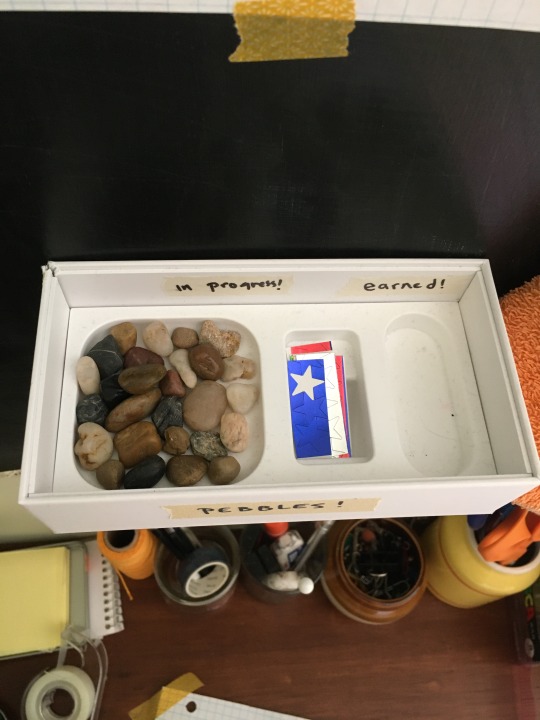
Prize box! It’s mostly fabric, since that’s what I have on hand right now. When I set up my system for the first time earlier this year, I went out & bought like $10-$20 on small things to fill it. my rule was no more than $2 per item. I think I stuck to it except for the space fabric which was $4. Tea, coffee add-ins, sheet masks, bath bombs, sheet music (if you play an instrument), earring hooks, beads, a plant pot, vouchers for things you can do in video games are all good too. I often put the next book that I want to read in my prize box, so it feels like an event when I finish a book and pick up a new one. Personally, I avoid putting any food/snacks in my prize box, because I find the idea of earning snacks to create some issues in how I think about my relationship to food. So I just avoid it entirely.
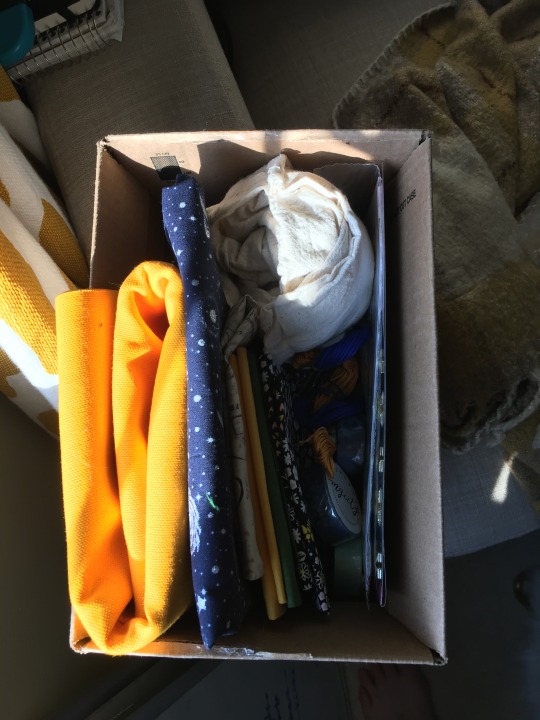
#adhd#adhd system#adhd task management#reward systems#adhd schedule#adhd hack#life hack#studyblr#studyblr hack
23 notes
·
View notes
Text
Episode Review- The Real Ghostbusters: Masquerade

Okay, whenever I see the title of this episode, I immediately think of that one scene in Phantom of the Opera. But of course, this episode has nothing to do with the Phantom. Although, if you liked They Call Me MISTER Slimer, you’ll probably enjoy this one, too.
The episode opens at with a bunch of kids playing around in a park somewhere. The focus quickly shifts to a select group of kids gathered by a park bench. I’ll give the animation team credit here because while most of these kids aren’t actually given names in the episode, they are a bit diverse in terms of character design. But there are two in particular that stand out the most. The first is the one who is named Willie Bradford. He’s a rather heavyset kid, and the obvious leader of the group of kids. The other is simply called Cindy, and she’s one of the only two girls in the group. (The other girl is nameless, though I think she could be the twin sister of one of the other kids there, as they do resemble each other a bit.) I have something to say about these kids, but I’ll get to that in a bit.
Willie announces that they should think of something to do since school was out for the weekend, and he suggests things like a trip to the beach or having a baseball game. But that’s when Cindy points out another kid is heading towards them. This new kid is named Kenny Fenderman. And we immediately see that Kenny is a Ghostbusters fanboy. He’s even dressed in a homemade Ghostbusters jumpsuit, complete with a Proton Pack replica. Right away, Willie and the other kids begin teasing Kenny about this. And this teasing gets worse when Kenny insists that he’s not wearing a costume and is in fact a full-fledged Ghostbuster. The only one who isn’t joining in with the other kids in mocking and laughing at Kenny is Cindy.
Okay, this is where I want to talk about these kids. While I did mention earlier about how these kids all have diverse character designs, you can still tell just by looking at them which character trope they fall under. Willie is clearly meant to be seen as a swollen bully and Cindy is the Nice Girl™ and potential love interest of the Nerd Kid™ (which Kenny is clearly meant to be.) I’m seriously wondering what it says about our collective psyche that we can tell just by looking at a character design what character trope that character is meant to represent.
Anyway, Kenny gets really upset over how the other kids are laughing at him for insisting that that he’s a full-fledged Ghostbuster, so he turns and heads off, announcing that he’ll prove it to them. It then cuts over to the Firehouse, where Egon is hard at work in his lab, with Ray watching him work. It’s quickly established that Egon had called for a staff meeting, but Peter is late showing up for it. (Don’t ask me why Winston seemed to be excluded from this meeting. Was it just because he doesn’t have a Ph.D. like the others, or did the animators just forget to include him in the scene?) The meeting was supposed to discuss a prototype for a new invention of Egon’s. This invention is called the Ecto-Aroma Eliminator, and it was designed to help eliminate the foul odors that are left behind from entities that were Class 3 or higher. Because it seems that those particular groups of ghosts emit a distinct smell. Of course, Egon makes it clear that this is still just a prototype, so the device is still experimental and therefore highly dangerous.
At that moment, Peter finally showed up to attend the meeting. But before Egon could get down to filling Peter in on what he’d missed, Janine calls Peter down to the lobby, announcing he has a visitor. The visitor turns out to be Kenny, who announces that he’s there to apply for a job with them. (And we see Winston is there with Janine. Again, why wasn’t he included in the staff meeting?) Peter brings Kenny into his office, where Kenny tells Peter that he’d already told the other kids he was an official Ghostbuster, but they all made fun of him. And he proceeds to beg Peter to give him an assignment. Peter, it seems, takes pity on Kenny and decides to humor him by reaching into a drawer and pulling out an old pin from the 1964 World’s Fair. He gives it to Kenny, announcing that the pin makes him an official member of the Ghostbusters Auxiliary. (Interestingly, this might be an Easter Egg. In one of the deleted scenes for the original movie, Janine gave Egon a coin from the 1964 World’s Fair as a good luck charm before they head out to battle Gozer.) Peter then announces, as a part of the Ghostbusters Auxiliary, Kenny should get a special guided tour of the Firehouse. This tour ends up including a trip into Egon’s lab. While in Egon’s lab, Kenny asks if he could have a piece of official Ghostbusters tech. After all, if he is an official Ghostbuster now, he should be able to have some official Ghostbusters tech. Peter, rather foolishly, shrugs and decides there’s no harm in this. And he hands Kenny the prototype Ecto-Aroma Eliminator. Because he missed the staff meeting where Egon made it clear this device was not perfected yet.
Kenny’s tour of the Firehouse is cut short when an official Ghostbusters call comes in. Although, Peter decides to invite Kenny to tag along with them. Ray, upon seeing Kenny sitting next to Peter in the Ecto-1, questions the advisability of this, but Peter insists it’s fine. Of course, to Peter’s credit, when they actually arrive at the sight of the paranormal disturbance (which turns out to be a ghost causing mayhem at a museum gallery of imported crystal glass items), he instructs Kenny to wait by the Ecto-1. So at least Peter isn’t being completely reckless in terms of Kenny’s safety.
Inside the gallery, the Ghostbusters get to work in dealing with the ghosts causing mischief. While trying their best to avoid damaging the crystal ornaments. Because the owner of the establishment stated that anything broken would be deducted from their payment. They have an easy enough time catching three of the ghosts, but there’s still one more ghost that manages to elude them. Just when they’re about to corner the last remaining ghost, however, Kenny decides to come bursting in to help. This naturally backfires, and Peter has to shove Winston aside to make sure Kenny doesn’t get hit by an Ion Stream by mistake. Still, despite the mishap, which also results in a few vases getting destroyed, they are successful in capturing the final ghost.
A short time later, Egon, Ray and Winston are loading up the filled Ghost Traps in the back of the Ecto-1. Ray states that, while Kenny is a nice enough kid, Peter never should have let him tag along. While Winston and Egon don’t disagree with him, they do point out that it was nice to see how Kenny seemed to bring out a different side of Peter. Which is a really good point. It was quite surprising to see Peter being so supportive of Kenny’s desire to be a Ghostbuster. It makes one wonder if Peter was picked on when he was a kid, too. Did Peter see a bit of his childhood self in Kenny? If so, the episode never confirms it.
Meanwhile, Peter is scolding Kenny for not waiting by the Ecto-1 like he was supposed to. Kenny is clearly apologetic, stating that he just got excited and didn’t mean to do anything wrong. In response, Peter harshly tells him that sorry isn’t good enough, stating that Kenny should just go home. Without another word, Peter gets into the Ecto-1. Winston and Ray tell him that he might have been too hard on the kid, but Peter doesn’t really respond to this. And so, they drive off, leaving Kenny standing there, visibly miserable.
Sometime later, Kenny is shuffling along, still clearly upset over what happened. He winds up at the park, where he runs into Willie, Cindy and the other kids again. Willie doesn’t hesitate to start making fun of Kenny again, and even shoves him to the ground. Kenny, trying to save face, once again insists that he really is a Ghostbuster, showing them the badge he got from Peter as proof. Of course, Willie quickly notices that it’s really just a pin from the 1964 World’s Fair, and the teasing continues. So Kenny shows them the Ecto-Aroma Eliminator, which he still has with him. This does stop the other kids from laughing, and Cindy asks Kenny what it does. Kenny, of course, doesn’t know. So he simply responds that it’s top secret, but that it puts away ghosts. Willie, on the other hand, doesn’t seem to be happy about this and ends up daring Kenny to prove he’s a Ghostbuster- by spending the night in the old Halliwell Mansion, a building in the park that is reportedly haunted by the ghost of Old General Halliwell. Kenny, despite clearly feeling reservations about this, decides to accept the dare, and he enters the Halliwell Mansion.
Back at the Firehouse, Egon has noticed the Ecto-Aroma Eliminator is missing. When he confronts Peter about the matter, Peter admits he’d given it to Kenny, thinking that there wouldn’t be any harm in it. After all, it was rather small. Egon informs him that Kenny is in serious danger, and that if the boy pushed the wrong button, it could destroy an entire city block due to the isotopes inside the Ecto-Aroma Eliminator being unstable. Therefore, it’s imperative they find Kenny ASAP. Their only chance of doing so would be to track down the Ecto-Aroma Eliminator with a Geiger Counter. Although, Egon points out that their chances of locating Kenny in time inside a city as large as New York are still rather slim. Still, they have to try, so off they go.
Elsewhere, Kenny is wandering around the Halliwell Mansion. He ends up turning on the Ecto-Aroma Eliminator and begins fiddling with it in an effort to figure out how it works. When he thinks he’s got it figured out, he makes his way upstairs. There, he comes face-to-face with a glowing red door. This is apparently the ghost of Old General Halliway, and Kenny tries to confront the ghost. But he only gets blown backward against a railing. Out of nowhere, three other ghosts appear and begin making their way towards Kenny menacingly. Just as they are about to reach them, Kenny half-falls over the edge of the railing, just managing to grab onto a conveniently placed chandelier, preventing him from falling.
At that moment, the Ghostbusters appear on the scene. It seems that when Kenny switched the Ecto-Aroma Eliminator on, it helped Egon get a lock on his current location. Peter, spotting Kenny hanging up on the chandelier, tells him to sit tight and be their lookout while they deal with things. The Ghostbusters proceed to go after the ghost minions inside the mansion, but the ghost minions seem to outwit them without much effort. So Egon consults his copy of Tobin’s Spirit Guide. In doing so, he determines that all the spiritual activity in the mansion is being directed by a single intelligence. But this presents an issue because if this singular intelligence has this much psychokinetic energy at its command, it could even be strong enough to blow up the Containment Unit from within. However, Egon theorizes that if an equally powerful kinetic force could blow it up upon being trapped, the conditions inside the Containment Unit would prevent the entity from reforming. Winston asks how powerful this kinetic force should be for it to work, and Ray states it would have to be at a near-atomic level. This gives Peter an idea. And, as he and the other Ghostbusters fire their Proton Packs at Old General Halliway’s ghost, Peter instructs Kenny to throw the Ecto-Aroma Eliminator at the entity. Kenny does so, and this results in the successful capture of the ghostly general.
After getting Kenny down from the chandelier, the Ghostbusters escort him outside where Willie and the other kids are waiting. (Were these kids sitting outside the mansion all night? Because based on the lighting in this scene, it’s early morning now. Where are their parents?) Willie and the other kids are all flabbergasted to see the Ghostbusters with Kenny, especially when they thank him for his help. And, when the Ghostbusters head off to return to the Firehouse, Willie sheepishly asks Kenny if he could introduce him to the Ghostbusters sometime. Kenny responds with a noncommittal answer and waves goodbye to the Ghostbusters as they drive off.
Overall, a rather cute episode. And I was particularly impressed with the animation during the climactic scene towards the end. I wouldn’t be surprised if they put a bit more money into the animation budget for that particular moment. That being said, I was wondering something in regards to Kenny throughout the episode. I’m not sure if it was intentional or not, particularly since there doesn’t seem to be any comments on the matter on the Ghostbusters wiki. But something about him made me think that he might have been on the autism spectrum. After all, he clearly had the obsessive interest down. Of course, I might be making something out of nothing.
(Click here for more Ghostbusters reviews)
2 notes
·
View notes
Text
Akiba Souken Interview with Jizue
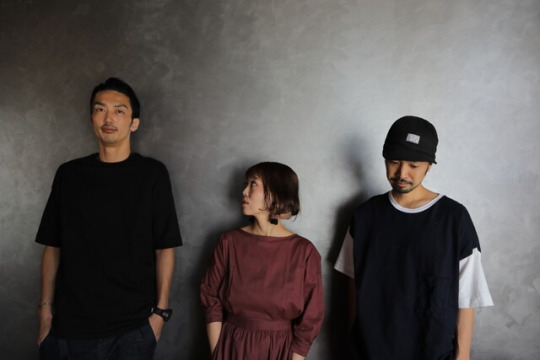
On the original soundtrack of “Hoshiai no Sora”, which demonstrated the uniqueness of Jizue.
The ones who composed the soundtrack of the TV anime “Hoshiai no Sora” were the instrumental band Jizue, which is based in Kyoto and widely active both nationwide and overseas. It is said that they, who claim to have always wanted to work with video, encountered “Hoshiai no Sora” due to a certain coincidence. Their music, which is pleasant to hear despite being so technical, draws the youthful patterns of a soft tennis club, matching splendidly with the worldview of “Hoshiai no Sora” as it approaches the emotions of middle school students. We have asked members Inoue Norimasa-san and Katagi Kie-san about the soundtrack CD, released on December 25th 2019.
Raw || Index || Ko-fi/PayPal ( ╹◡╹)っ’・*
Being provided with an environment where they could unleash the uniqueness of Jizue.
——Jizue is a band with a long career, right?
Inoue: We used to be a song band at first, but it has been thirteen years that we became an instrumental one.
——Why did you decide to be an instrumental band?
Inoue: Counting with the drummer who has left the band by now, we, the three male members, were childhood friends from grade school. We had always been a song band, but we sensed limitations somewhere along the way, so we decided to create cool sounds with just our instruments. Then, we started wanting a pianist, so we added in (Katagi) Kie-chan, who was an acquaintance of our drummer.
Katagi: I was always alone, playing from classics and jazz to pop, so Jizue was the first band I ever joined. Since it is an instrumental band, so I could play the piano as much as I wanted, and it is really fun to build up strength by overlapping with the other instruments.
——Instrumental bands have an image of talent to them, so hasn’t this genre been on a rise in the past years?
Inoue: I do not know whether it has been on a rise or not, but many cool instrumental bands have been around since the time when we started ours, and in comparison to before, I think this genre has been receiving more recognition lately.
Katagi: Instrumental bands have been blending into regular rock festivals often, and costumers who got to know about the genre through soundtracks for doramas have been gathering up at live concerts.
——In these circumstances, Jizue started making music for animated works, right? How was it decided for you to be in charge of the “Hoshiai no Sora” soundtrack?
Inoue: This is something that we also only came to know about later, but the cue was that the director of the recording company happened to have listened to one of our songs, “March of Monkey”, by chance. Then, he looked up the band name and recommended us to the anime’s staff.
Katagi: We had made music for commercials before, but it was our first time working with a soundtrack, so we were happy.
Inoue: Like, “A soundtrack commission has finally come our way”. We were happy, but at the same time, we had no idea how to make it (laughs). At the first meeting, Director Akane said that he wanted us to create Jizue-like tracks without being too conscious of the anime’s worldview, so we were relieved.
——How was Director Akane’s first impression?
Inoue: There were no detailed orders like, “I want you to add a sound like this” or, “I want you to use a melody like that”, so I thought he was the kind of person who was going to let us create freely. The only thing that surprised me was when he told us to make forty or more short tracks, with one to two minutes of length for each. I wondered if people make that many tracks for an anime.
——I believe the specific orders for the tracks were made through a music menu. How was it?
Katagi: Yes, we received a menu. The emotions he wanted us to express through certain tracks were written there, together with their length and tempo, so it was a new way of ordering.
——Who wrote the compositions?
Inoue: I was mostly the one who did it. All the members of Jizue write tracks, but we thought had to bring out a sense of uniformity for the soundtrack, and that it was necessary to have someone take the initiative. So I allocated the members, asking Kie-chan to take care of the piano tracks.
Fast and clear melodies are one of the “flavors” of Jizue.
——How did you get into composing the tracks?
Inoue: There was an order from Director Akane for us to make a number of main songs, so we started from there. At first, we made three-minute tracks like usual and went on to consolidate their images. The initial tracks from the OST, “Ingenuity”, “W -Hoshiai no Sora-“, “slow and sure” and “heart rate”, were conceived like that.
——“W -Hoshiai no Sora” was also included in your latest album “gallery”, which you released July 2019, with the title “W”. Does that mean you already had this track from the very beginning?
Inoue: No, it is a song that we made from scratch for “Hoshiai no Sora” and we liked it a lot, so we asked permission to include it in our own album. “W” is a title we put on it with both the meaning “doubles” and of “versus”, as in fighting against an opponent, and it is a song that we made with the excitement and dizziness of a game match as its image.
——It is often used in the anime and is also the track that represents “Hoshiai no Sora”.
Katagi: When I watched it online, the comments would go, “Here it is~” in unison whenever “W -Hoshiai no Sora-“ started playing. That made me happy.
——Katagi-san’s high-speed piano is cool and I think everyone loves it.
Inoue: Melodies like that are one of Jizue’s quirks, so we thought we should use them in this soundtrack too, no matter what. Ever since the earlier stages, we have been adopting passages fast enough to make people go, “So they can play that much”. I believe that this gap of having clear melodies in-between is characteristic of Jizue, so for this time, I would write phrases that were, if anything, quick-paced, and would ask Kie-chan, “Can you play this?”.
Katagi: I played by practicing a lot (laughs). “W -Hoshiai no Sora-“ has a tense air to it and I think it is a cool track.
Inoue: The track is not just hard to play - there is a sense of liberation from the hook’s melody, so it resulted in a track that is easy to ride on. Not just the anime’s staff but also the people who watched the anime have liked these tracks that we made the way we wanted, so we have this feeling that we created good tunes.
——This time, when you were making the soundtrack, what did you have in mind?
Inoue: There are tracks in it that last less than a minute, so I had wondered for a moment if people would enjoy listening to such short ones, but when I listened to them in sequence when working on the mixing and mastering, they sounded amazingly good. If I had to tell you why, I would say it is the track’s feeling - there is this sensation that the feelings of the tracks we want people to listen to the most are lined up in rows. When I realized this, I found soundtracks to be fun.
——I believe there were tracks for depictions of everyday life that you would not normally make. How was it trying to produce these tracks?
Inoue: We made them enjoyably, without any resistance whatsoever. We had the desire to bring out the uniqueness of Jizue even in such tracks, so I think they turned out as slightly eccentric daily life tunes. For example, their tempo becomes irregular.
Katagi: Nori-chan is the genius type when it comes to songwriting. Just from him humming a tune that he came up with at random, the tempo becomes irregular, but you can listen to it without any sense of misplacement whatsoever, even when the time signature goes from seven to eight. He is also a recording engineer, so by the time he creates a melody, he already has an image of its sound as a whole in his head.
——So you have a clear vision of the final form from the initial phase of composition.
Inoue: I do. This specially applies to instrumental bands, but I believe that the coolness of a track changes greatly depending on its sound design.
——While Jizue’s compositions are complex music pieces backed by advanced techniques, I had the impression that they were easy for the ears to get familiar with.
Katagi: Normally, when we are creating them, we members have an unspoken consent to make the hook’s melody into something that people can sing to, no matter what. Beautiful things will definitely resound within people’s hearts, regardless of how difficult they might be, so we think it is good to put in such melodies.
Getting to create tracks that take a full swing on emotions due to being given a setting from the outside.
——I felt that the nature of Jizue’s music was a perfect fit for “Hoshiai no Sora”.
Inoue: It makes me happy when people who watched the anime think so. When making them, we wondered about how the sounds would go with the animation, but when we actually saw it on-air, they matched so well that even we were surprised. As expected of that anime’s staff, starting with the director. We made countless tracks for the games, but all of them were used in good ways, so since they match so well, I wanted to have made even more of them (laughs). As we made a soundtrack ourselves this time, I started paying attention to the soundtracks of other animes.
Katagi: We would look forward to every episode of “Hoshiai no Sora”. We were only told the story of the early stages, so we were curious about the continuation.
Inoue: We were told it would have not just a sense of youth but also pain, yet I had not imagined it would be this much of it (laughs).
Katagi: In the menu, there was a specification like “fear toward his father”. We made a dark song with just the piano, but when we watched the initial parts on-air, the dad turned out to be way worse than we had pictured.
Inoue: The episode about Itsuki-kun getting the burn marks on his back was a huge shock, and I was like, “You can’t do that to kids, no matter what!”. But the mother’s suffering was also conveyed and felt realistic. I got sad.
——This is a series where the amount of painful scenes is not small, so while making tracks for youthful scenes and heated-up tennis scenes, you also had to make sorrowful and disturbing ones.
Inoue: And make them we did. There are not such dark tracks amongst our usual ones, but I personally like melodies in minor a lot, so I made them without any resistance.
Katagi: We were able to shake off our emotions and create these tracks thanks to the setting being given to us from the outside, like how it went this time. We normally write tracks while picturing sceneries and stories that have moved our own hearts, but we had never made such worked-up feelings into the theme.
Inoue: It was interesting to make them by being granted a theme. And I was really happy to have a proper response and see them properly matching the animation.
——Who decided the track titles and order for the soundtrack CD?
Inoue: I decided on both. For the track order, firstly, I wanted to line up the tracks we made as the main themes of the series, going from the lighthearted tracks into the dark zone from that point on, and then make a beautiful flow toward the ending theme, “Kago no Naka no Bokura wa”. I really like the opening and ending themes of “Hoshiai no Sora”.
Katagi: I think coming up with titles for all thirty-four tracks was a hassle (laughs). You did a lot of research on English language when thinking about them, right?
Inoue: I thought they had to match the mood of the tracks no matter what. Also, there is a code hidden within the titles altogether.
Katagi: There is actually a meaning as to why there is upper case mixed with lower case.
Inoue: We hope people enjoy this too.
——Do you want to keep making anime soundtracks from now on too?
Inoue: We so do. If any anime’s staff calls to us, we want to do it right away (laughs). A discussion has been raised about us making a series by merging Jizue itself with animation, and there are many opportunities to deliver our music through video series collaborations with an apparently wide scope of people, so we would like to keep actively going at it in the future too.
#hoshiai no sora#hns#sportsanimedaily#fysportsanime#stars align#jizue#hoshisora#interview#my translation
16 notes
·
View notes
Text
Bravely Default and BD2
Here it is, the partially prompted bravely default rant/retrospective/whatever the fuck!
With the announcement and demo of bravely default 2 out now for a bigger market than the original game ever had, I feel that as a massive fan of the original I should put some amount of effort into explaining what the appeal of the original is, why bravely second missed a lot of the appeal, and why bravely default 2 has been very, very worrying so far.
If you care about any of that, come on in and I'll try to actually avoid spoilers this time and make this a more legitimate recommendation of a game than usual.
THE APPEAL OF BRAVELY DEFAULT
The games obviously have a beautiful art style, especially when it comes to the backgrounds. Every city is like a painting, a beautifully composed shot that you see from just one direction to give you one very strong impression. While the overworld and dungeons are fully 3d and do not have as strong of an artistic impact, they are still very competent and have good colors and cohesive elements.
The character design, including the job outfits, the monsters, and all the villains are just top notch. Simple, evocative designs that make the most of the 3DS' limited hardware and build upon the teams skill in making handheld games look good. (its the same team that did the ff3 remake and 4 heroes of light, which looks absolutely kino on original DS) The music is also consistently excellent, with great use of motifing, a full and varied orchestra, and many good slow paced tracks for most of the non-combat segments. Shit like "Conflict's Chime" being the main battle theme, "Infiltrating Hostile Territory" being a common dungeon theme, and "That person's name is" as the rival boss themes makes even the seemingly repetitive songs a constant joy to listen to.
The story is pretty decent, it's not the best part of the game, and there are definitely some aspects of the story some people loathe, but the characters (specifically ringabel fuckin love him) are pretty good and the make for an enjoyable experience. The side material like D's journal are really well done and integrate into the main narrative well for how tucked away and ignored it is.
The gameplay and systems are also some of the best of any RPG I've played, and I've played far too many. The job system from ff3 and 5 is brought to an even greater depth with the addition of universal job abilities, allowing any character of any job make use of another jobs features to create an endless depth to strategy. The way various jobs can mingle together, and how no job is completely perfect on its own makes for very compelling team composition and unit design. The extensive amount of jobs helps as well for replay value and for assuring that no easy winning strategy is found by all players.
The BP system makes battles take on a very unique pacing as the player and enemies can choose to save up turns or blow them all at once to make more complicated strategies possible, or to make the most of an enemies vulnerabilities. This powerful option gives the player a meaningful way to capitalize on their knowledge of the game, while also allowing them to make truly detrimental mistakes. That may sound not good if you're a fucking baby, but nobody wants an RPG you cant lose, but losing because you fucked up is much better than losing because the enemies are just stronger than you or anything to that effect.
But the single greatest part of bravely defaults, which creates the games wonderful balance and unique design philosophy, is that the player is expected to hit the level cap long before finishing the game. Reaching level 99 should occur somewhere just after the middle of the game, at the point where the player has access to almost every job and has encountered almost every type of threat. Reaching level 99 brings with it a certain security, the implication that from then on, all enemies will also be level 99, and that any failure to defeat an enemy will be a result of a bad strategy or the players own mistakes. The game is not easy, and is certainly intended for veteran final fantasy players used to the games with job systems and changing up your entire party to combat a single encounter. Leveling up is not a slow grind part of the game, as you have a lot of control over the speed and frequency of battles, and it is not difficult to keep up with the games level curve.
The other layer to this unique design is that the game expects you to "cheat", or use strategies that would be overpowered and frowned upon in most other games. Bravely default easily expects you to know or discover strategies such as: applying a status to all enemies and killing every enemy with that status using another spell, cycling a counter move over and over to have a nearly invincible party member, applying a healing attribute to a self-damaging character to get huge damage at little cost, casting reflect and dangerous spells on your own party to bounce them at the enemy, or duplicating a move that does maximum damage 15 times in a row. The game builds all of its encounters with the knowledge that your team will be the maximum level and that you will be using the most vile tactics you can come up with, and the game will do the same. Bosses and even common enemies will employ equally vile tactics using the exact same moves that you have access to, meaning you can learn from your enemies or quickly grasp the enemies strategy through your own experiences. One of the late game dungeons is entirely optional, but involves several fights against parties of 4 just like your, using the same jobs and skills you have gained during the game as a perfect test of your ability to develop counter-strategies, instead of relying on your own overpowered tactics. This type of design is really not something you find in many games due to the prominence of grinding or the lack testing strategies, and it is the most true appeal of bravely default to me.
BRAVELY SECOND EXISTS I GUESS
So bravely second, a direct sequel to bravely default, definitely is a video game. It uses the original game as a base to generate more content, but completely misses the appeal of the original, and the new content added makes the experience even less focused. Overall, it's still a fairly alright RPG, but it fails to follow up on bravely default in a meaningful way or to provide as compelling of a gameplay experience. Here's some of the things it fucked up.
The game reuses almost everything the original game had, including the same music, world map, and most of the original's towns and dungeons, while adding a few of it's own. Going through areas you've been before never feels good, and the new areas lack the quality or brevity of the original game, leading to uninteresting areas that overstay their welcome, despite being the only break from repetitively reused content.
This extends to the classes but in an even worse sense. One important trait of the original jobs is that they were not perfect by themselves. While every job provided some useful abilities to be shared with other classes, or provided a good base with which to make a character, no class was without flaws. The new classes in bravely second are a lot of the opposite, they are closed loops that think of everything they could have to make a good standalone character. The 4 starter classes you get in bravely second are all brand new, and there's almost no reason to use any class besides those 4 as they are just insanely good. The priest and magician specifically augment magic in a way that makes spells infinity scalable into the end game, completely trampling on any other magic classes territory without needing the extra effort of grinding a new class out. Many of the new job concepts are actually really interesting, like going back in time to return to a healthier state, or a class that changes the stats and attributes of all units in a battle, allowing for all new kinds of strategies; but these classes lack any opportunity to be used to their full potential since they don't mesh well with other jobs and are limited by their self-centered design.
Another completely missed aspect of the original is the level curve discussed before. Bravely second only really requires you get somewhere in the ballpark of level 60-70 to comfortably beat the final boss, and getting too leveled up is really hard to avoid if you are plan to try out various jobs.
Second also fails to account for how many incredibly strong strategies the player can come up with, and even introduces some of its own strategies that it has no way to counteract, such as halfsies (the first skill the first class gets) pretty much splitting the game in two by tripling the value of items like phoenix downs, and allowing for fool-proof strategies by making 1 character focus entirely on defense, effectively making the party unkillable. Essentially, if you play second after having played the original (like any sane person would) then you will absolutely destroy the game with no sense of satisfaction.
The story is also a large step down, enough to become an annoyance, as the writing style changes to a strange romantic comedy situation with, for lack of a better term please forgive my sin, anime writing, but like bad anime writing, ya know the kind of shit that makes people write off all anime cus a lot of it is awkward and unpleasant to listen to. The story tries to mess with some big concepts like "what if new game + was a real thing???" and time travel and shit like that but it doesn't mesh with the tone the rest of the game has and that tone doesn't mesh with the world or art style and it's just a mess.
BRAVELY DEFAULT 2 SEEMS KINDA POOPIE SO FAR
So unfortunately, the big appeal of bravely default being part of it's end game makes it hard to judge how 2 is gonna go given we only have a demo of the beginning, but given that the original team behind bravely default has slowly been stripped out of the series as it goes on, the outlook is bleek.
Most immediately obvious is that the artstyle has made a horrible transition from handheld to console, somehow even worse than pokemon. The areas are all fully 3d and lack the style or compositional excellence of bravely default, and the outside environment look like asset store products. The small proportioned characters with simple features to be readable on a small screen have been replaced with identically proportioned characters with excessive detail and ugly features, and look horrible up close on a big screen. Only the negatives of the art style have made it over, and everything good has been made unsavory. The character and enemy design overall is much worse as a result, everything is messy, unclear, and clashes with everything else. It's an absolutely shocking downgrade.
The characters themselves are overly hammy and feel like shallow attempts to have a similar party dynamic to the original without having identical character types, and the writing as a whole doesn't seem to have improved from second, which was already quite a step down from the original.
The gameplay also has not done anything different or interesting yet, and seems to be selling itself to people haven't heard of or gotten enough of the BP system. Enemies being on the overworld as opposed to random encounters shows they have dropped the player agency over encounter frequency, which is dumb. The battles lack any of the flow the original had, especially when using the battle speed option, as the camera does not present everything very well and changes position often as a result. Overall, I have not enjoyed the bravely default 2 demo and feel it shows nothing but a continued decline in the series that likely should have just been a single game. With the release date being set for sometime this year, I feel there is no chance any amount of player feedback could save the game or even begin to pull it in the right direction, as it seems to be fundamentally flawed with an inescapable feeling of shovelware.
SO WHAT?
Basically, all I wanted to say here is that the original bravely default is a very unique experience I think every RPG fan should give a good chance (and just do all the optional stuff during the "repetitive" part of the game, it's where all the best content is you bozo) and that the sequels are NOT the same experience. I guess it's kind of mean to just say "hey don't buy or like this new thing cus its not like the old thing" but people should know why there's a bravely default 2 in the first place, and should fight for what made the original great. I worry that BD goes down the same sad path that FF did, becoming a completely hollow, middling series that strayed so far from it's home that a whole new series had to be made to give the fans of the old style a place to go.
Thanks for reading, and hope you got something out of it.
#bravely default#bravely series#bravely default 2#juvenile rant#vote now for the next rant! including things such as The Great Ace Attorney and why it's kino#or why i think arms is a really well designed game even tho i'm fucking shit at it#very exciting topics indeed#or ya know whatever other shit you think i have a lot to say about
45 notes
·
View notes
Text
Bleach - Name Games
Not a family by name or blood, but a kind of found family. (at least the way they were originally presented) This time I’m tackling the Visored! And while I’m at it I want to address some of the broader thematic elements going on with their original character designs. Buckle up, this is a long one...
Hirako(平子) Shinji(真子)

Shinji’s name is actually kinda of a false start to this one. His names read as “Flat-Child“ and “Real-Child“ but that’s keeping in mind that -ko(子) for “child” is actually just a really common suffix for names, and not one generally used to ascribe literal meaning. (Typically because of its diminutive implications it denotes a female given name, but it applies neutrally to family names, and even generally is not uncommon in male names.) So his name kind reads as “Flat Reality“ or “Flat Truth.“
But this one isn’t actually about the meaning of the words, it’s a different kind of name game. As we all remember, when Hirako introduces himself to Ichigo’s class at Karakura High during his original entrance at the start of the Arrancar Arc, he writes his name on the board mirrored and mentions how he’s “good at doing things backwards.” At the time it was a reference to him being a hollow (Remember that when Ichigo’s inner hollow was given a chapter cover, his “name” was Ichigo’s but written mirrored) and would later influence his zanpakutou, Sakanade(逆撫)
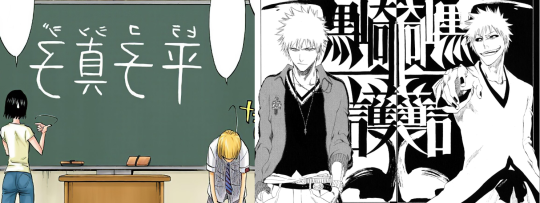
As an aside here, Sakanade(逆撫) has been kind of erroneously translated as “counter stroke” in English, which is technically accurate as a literal translation but is kind of needlessly vague; For one the word “Stroke” here specifically refers to the act of stroking as in petting, patting, or smoothing over, and not something like a sword stroke; secondly the “counter” here should read more obviously as “reverse,” “opposite,” or “inverted.”
Moreover, Sakanade(逆撫で) is an actual verb already, so it doesn’t actually need to be broken down in the first place. The word actually means exactly what it sounds like as well as having a colloquial use as, “rub the wrong way.” Yes, other than just meaning to literally “pet in the opposite direction” (as with petting a cat or dog from tail to head) it means “to irritate” or “to annoy,” (which the former action invariably does) and that is an apt description of Sakanade’s powers.
Anyway... About Hirako’s name not being about the meaning: the joke is that whether you write the name forward or backwards 平子真子 -vs- 子真子平, you still get Shinji(真子) out of it. As in, his name is still legible both forwards and backwards. Plus both kanji, 平 and 真 have horizontal symmetry, so they don’t change when mirrored..
⸻⸻⸻⸻⸻⸻⸻⸻⸻
Okay... let’s do an easier one...
Sarugaki(猿柿) Hiyori(ひよ里)

My personal favorite Visored, has a nice straight forward name Saru(猿) as I’m sure anyone amply familiar with anime knows means “Monkey” and the Gaki(柿) is the word for the fruit “Persimmon.” The image of a monkey in a persimmon tree references an old folktale present in various east-asian cultures about a greedy monkey who cheats other animals before eventually receiving its comeuppance at the hands of the animals it has wronged. In this case it’s reflective of Hiyori’s general image, sandles, track suit, decidedly tomboyish and unladylike; the “mountain monkey” is a poor, rural character type in Japan, not dissimilar to the American hillbilly of the Appalachia.
In that same vein, the name Hiyori(ひよ里) has a peculiar rural slant to it, in that it uses hiragana in place of the first component. The ri(里) is a common place indicator in surnames meaning “village” or “hamlet” but like many Japanese surnames that reference landmarks like -kawa(川)“-river,” “-yama”(山)-mountain,” and “-da”(田)”-field,” the important part isn’t actually the locale but the descriptor preceding it; Which mountain? Which river? Which field? Which village? In the case of Hiyori, it’s not clear... The fact that the village she appears to be named after doesn’t have a kanji again lends to this impression that, like the peasants of Soul Society’s Rukongai, the person who named her didn’t know how to read or write kanji.
⸻⸻⸻⸻⸻⸻⸻⸻⸻
Muguruma(六車) Kensei(拳西)

I think this one has gotten pretty good visibility in the fandom already because of the relation with Hisagi Shuuhei. The eventual explanation of Hisagi’s 69 tattoo would be that it was copied directly from Kensei’s, and that Kensei’s comes from a mix of his name Muguruma, and the fact that he was captain of the Gotei 13’s 9th squad. (Personally I don’t like this explanation, and I think there’s pretty reasonable cause to assume this was a later decision and not a part of Kensei’s original conception or design.) But the reason behind that being Muguruma(六車) Mu(六) which is the Japanese numeral “6″ and Guruma(車) meaning “wagon” and later updated to mean “car.” In the Turn Back the Pendulum sidestory, this name is played upon in how Kubo styled Kensei’s 9th squad as a Bousouzoku(暴走族) the term for a Japanese biker gang (although they often include sports cars), where the “Six Car” reading becomes emblematic of his gang.
There’s a lot about the Bousouzoku that is culturally specific to Japan, but much of the familiar American cliches do actually carry over. One distinct aspect of how the Bousouzoku opperate however, is that they are predominantly a youth culture phenomenon, as any wide spread, organized criminal activity among adults quickly steps on the toes of the much better established Yakuza scene. For this reason it is very rare for Bousouzoku to persist in direct group activity into their adult years, although often bikers become easy recruitment targets for Yakuza.
Kensei(拳西) is actually an odd one for me. It’s both super straight forward yet somehow together really obtuse. Ken(拳) for “Fist” and sei(西) for “West;“ both are pretty singular in their meaning, so it’s not like there’s any uncertainty to what each one means, but I can’t make heads or tails of the two together. For one, Ken(拳) is usually something you’d see put on the end of a compound, and when it’s used that way it tends to denote a kind of martial arts style or technique. It might still be meant to read as “Western Fist” or essentially “Western [style] Fist” and Kubo just liked the sound of Kensei over Seiken. It might be a reference to the fact that Kensei’s original design was largely reminiscent of a kind of military look and feel, with a combat knife for a zanpakutou, short hair, combat boots, and pants that look like they could be part of military fatigues. (the tank top sorta throws the look off, though.) But this was a theme that was dropped by the time the Visored got reincorporated into the story after their long absence.
⸻⸻⸻⸻⸻⸻⸻⸻⸻
Yadoumaru(矢胴丸) Risa(リサ)

...is another odd one. Her surname, Yadoumaru(矢胴丸) has pretty clear implications, Ya(矢) means “arrow” and dou(胴) means “hull” as in the part of a ship, and maru(丸) doesn’t actually have an explicit meaning. The kanji does generally mean “round” or “whole” both in reference to a circle, but it is most notably a suffix used in naming both naval ships, and frequently boys. Given the rest of the name the imagery seems clear, Yadoumaru(矢胴丸) is meant to read as “Arrow-Hull Ship.“* And although the uniform has heavy ties to school girl aesthetics and fetishism (which in turn link to her preoccupation with adult books) the tie here actually seems to be to the origins of the Japanese school girl uniform as a modification of the European naval uniforms introduced to Japan in the 1800s.
*edit: I’m an idiot. A Yadou(胴丸) is the sleeveless chest plate and skirt piece in traditional samurai armor, which also carries over into kendo sports armor.
Adding to this, the name RISA (sometimes romanized as LISA) being written in katakana and not kanji or even hiragana works together with the naval associations would seem to imply she’s of mixed birth? Possibly the daughter of a foreign naval officer stationed in Japan, hence a Western name and a ship as a surname? In fact, most Japanese ships would be named after some mythical figure or indeed named like a person, so the literal descriptor of “Arrow-hull” actually sounds like what someone would call a ship they didn’t know the name of, tacking “-maru” on to the end.
⸻⸻⸻⸻⸻⸻⸻⸻⸻
Let me also take a moment here to complain about the fact that Kubo originally wrote Rabu(ラヴ) and Roozu(ローズ) as katakana, pretty clearly denoting them as the English words LOVE and ROSE and while those seem pretty implicitly like nicknames it also implied in conjunction with their designs that they were both foreigners. So the fact that he retconned them to being nicknames based on more conventionally Japanese when he decided to make them previously SoulSociety shinigami names bugs me... But that being said
Aikawa(愛川) Rabu(羅武)

Man, what is it with Kubo and black people and “love” gimmicks? Zomarri’s Amor, and PePe’s The Love, Love’s whole thing... The name Aikawa(愛川) means “Love River,” and Kubo’s clever shorehorning of kanji into the phonetics for Rabu that he’d already used for the nickname Love use Ra(羅) for “silk,” but specifically a thin or sheer kind, and bu(武) for “warrior”/”soldier.“ The associations with sheer silk and negligee seem very intentional, so his name really is basically “flowing love, [sexy] silk soldier.“ And that’s it, it’s actually super straight forward. I dunno why he looks like an unemployed slacker, in a tracksuit and sneakers, lounging around reading manga, though.
⸻⸻⸻⸻⸻⸻⸻⸻⸻
Otouribashi(鳳橋) Roujuurou(楼十郎)

This might be my favorite as far as name games within the Visored. The given name Roujuurou(楼十郎) means “Watchertower 10 Son;” Rou(郎) being an exceedingly common suffix in boys names meaning “son.” (this is incidentally how anyone with a rudimentary familiarity with Japanese knew for certain Yuushirou(四楓院) was a boy at first glance, where as a bunch of other people thought he was a girl. In case any of you were around certain fandom circles for that whole drama... More on him later though, because he’s got a fun name too.) It’s not super clear if the arrangement here denotes the “Son of the 10th Watchtower [family],” or the “10th Son of the Watchtower [family].”
The surname Otouribashi(鳳橋) is a great little work of poeticism, where Outouri(鳳) is the Japanese name of the Chinese Feng(鳳) which in the most colloquial sense could be translated as “Phoenix,” but there’s a little more to it than that...
See, the Feng is itself the male half of the mated pair of mythical birds together called the Feng-Huang(鳳凰). The Japanese pronunciation Outori is actually directly taken from Ou(王) meaning “King” and Tori(鳥) meaning “bird.” The mythical Feng-huang is in fact king of birds, but more broadly represents a union of yin and yang, and is a common visual element of Chinese weddings evoking harmony. As a part of this theme of unity it is said to share features of many different birds, and also of the 5 fundamentally opposed colors associated with Chinese daoism and fengshui: Red, Blue/Green, Black, White, and Yellow. This particular feature has been tweaked over time to depict the Feng-huang as more broadly multicolored, and associated with the rainbow. (it’s also the basis of the Pokemon Ho-oh, if that wasn’t apparent) For a number of different mythological similarities, the Feng-huang have become erroneously thought of as “the Chinese phoenix,” but I’m not going to get into all that here...
So, getting back to the name, Bashi(橋) means “Bridge.” The, again false equivalence based, but more easily understood translation of Otouribashi(鳳橋) thus being “Phoenix Bridge.” But what is shaped like a bridge and directly associated with the Feng? A rainbow. His family name is just a really fanciful and kind of poetic reference to a rainbow. In conjunction with the “Watchtower” referenced in the name Roujuurou(楼十郎) I’m tempted to take to the meaning of “10th [Floor of the] Watchtower Son” as it implies a high floor, and in the common mythological motif of rainbows as actual physical structures, a high tower would be the sensible entry point to a rainbow bridge.
Also this is why he has a bird mask.
⸻⸻⸻⸻⸻⸻⸻⸻⸻
Kuna(久南) Mashiro(白)

Let me just come right out and say that I haven’t got a damn clue on this one. Mashiro(白) means “White.” Ku(久) means “long time,” na(南) means “South.” She dresses like a super sentai character, specifically one of the original Himitsu Sentei Goranger team, and her mask is a nod to Kamen Rider, with its antenna and big round bug-eyes. I don’t really see a connection with the name and the tokusatsu theme though.
Small aside, Tokusatsu is a genre of Japanese TV and film that was originally named for its emphasis on special effects like camera tricks and editing in post, used most noticeably in children’s shows like Super Sentai and Kamen Rider. That distinction became less and less relevant as special effects became more widespread, and so it is now used mostly to refer to live-action costumed super hero shows.
Super Sentai is btw the source material for the American franchise, Power Rangers, from which Saban Entertainment originally bought the footage that they would cut together with their own original footage, and later from which they would buy the costumes in order to shoot their own shows from scratch.
Also of note is that Ishinomori Shoutarou, author of the original Cyborg 009, was also the original show creator of Kamen Rider and Super Sentai. His work created the transforming(henshin) hero, the body suit and helmet aesthetic, and the heroic billowing scarf, effectively inventing the Japanese superhero almost single-handed.
⸻⸻⸻⸻⸻⸻⸻⸻⸻
Ushouda(有昭田) Hachigen(鉢玄)

Another funky one... “[To] Exist [in] a Shining Field” might be the best way to read Ushouda(有昭田)? Its really the U(有) that gives me trouble here, as it just means “Exist”/”Existance.” And Hachigen(鉢玄) seems to read Hachi(鉢) meaning “bowl” and Gen(玄) meaning “deep,” “mysterious” and in certain contexts “occult.” I’m not sure if that “deep” is really a physical deepness or just a sort of “profoundness” that would fall more in line with “mysterious” and “occult.”
Either way I think the general meaning is actually pretty clear, “bowls of rice from a shining field” evoke an image of kind of mythical field of magical produce, eating from which grants a kind of magical quality and sustenance. In other words, his name is saying that Hachi is such a huge guy and so gifted at magic because he ate a lot of food that grants magic power.
I have no idea why he has the tux or the shaved hair though. Stage magician? Fancy gourmand? But again then why the shaved head and the cross bones? And Kubo did eventually come up with for him is strangely Balinese looking? It seems reminiscent of Barong, king of spirits; A benevolent lion/bear monster that defends mankind from Rangda, the demon queen and master of blackmagic. But apart from the superficial appearance and broad ties to magic, there’s not a lot really tying the two together.
⸻⸻⸻⸻⸻⸻⸻⸻
It’s hard not to just go off on all the weird little design choices, and loose ends, dropped plot points, and retcon’d details that surround the Visored in Bleach. They really were just such a great concept utterly wasted by terrible pacing and some truly confusing priorities as far as publication goes, eithe ron Kubo’s part, editorial, or both... But that’s a story for another time...
#Bleach#hirako shinji#sarugaki hiyori#muguruma kensei#yadomaru risa#aikawa love#otoribashi rose#kuna mashiro#ushoda hachigen#visored
357 notes
·
View notes